
Module 3:
Marketing with
Facebook Ads
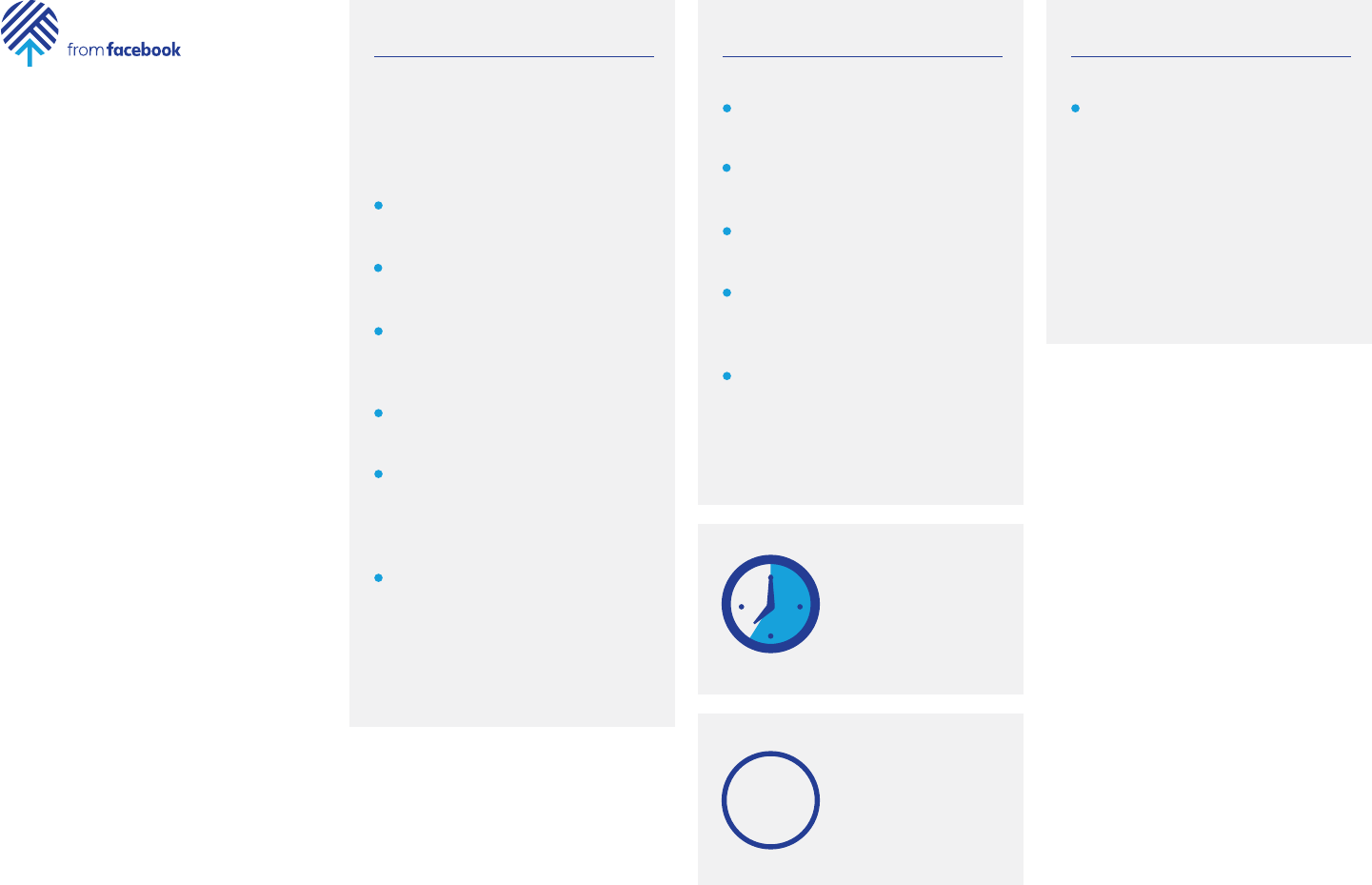
2
Social Media
Marketing
Learning Objectives
Students will learn to create
Facebook Ads using Ads
Manager
Understand the basic process
needed to create an ad
Understand how to determine an
objective for an ad campaign
Understand how to use Ads
Manager to target ads to specific
audiences
Understand how to set a budget
and schedule for an ad campaign
Understand how to use Ads
Manager to create various types
of ads (image, video, slideshow,
carousel, etc.)
Understand how to use Ads
Manager to monitor and measure
the performance of an ad
campaign
Skills Aquired
Determine the right ad objective
for a business’s goals
Use tools to target specific
audiences for an ad campaign
Set a specific budget and
schedule for an ad campaign
Produce ads of different types
(images, videos, slideshow,
carousel, etc.)
Use tools to monitor, measure, and
edit an ad campaign to meet the
campaign goals
6-8
hour
class duration
3
sessions
plus out-of-class
homework
Challenge
Create a simple ad campaign
for your organization that is in
line with their specific business
goal(s). For example, this could be
creating awareness through an
event, generating leads for new
members, selling a product or
service, or boosting loyalty to the
organization.

3
Social Media
Marketing
The rise of social
media has had a
dramatic effect
on how people
communicate with
friends and how news
is spread, but possibly
no industry has seen
more change than
than the advertising
world.
Remember Nielsen ratings? That’s
where data is gathered on the
viewing habits of one or two million
people in order to understand
what they are watching on TV, and
it’s used to determine the cost of
television commercials. It used to
be best way to estimate what an
audience would do. Today, that data
is much more comprehensive and
much more specific.
The more you know how to appeal
to specific demographics and how
to measure your ad’s effectiveness,
the better prepared you will be as a
social media marketer. Even if your
organization is nonprofit, advertising
is an excellent outreach tool.
In this module, you will work with your
organization to create and run at
least two ad campaigns. Because the
process can be a little complicated,
we’ll take you through it step by step
in the following six lessons:
WhyAds?
Organic vs paid ads
The Basics
Overall process
Choose Audience
Target specific audiences
Ad Placement
When and where your ads are
shown
Budget and Schedule
Determine a good budget
Create Your Ad
Create beautiful, compelling ads
Manage and Measure Your Ads
Ad performance
Remember, this is the fun part! This
is the chance to get creative and
learn how to create compelling ads
that help your organization add
members, sell products or services,
have a successful event, or whatever
business goal you have!

Module 3: Lesson 1
Why Ads?

Module 3 Lesson 1: Why Ads? 5
Social Media
Marketing
Why should I buy ads on Facebook?
Advertising on Facebook
is relatively inexpensive as
compared to other channels.
This graph from Brian Carter’s Moz
article really says it all. In terms of
cost to reach a thousand people,
Facebook is far less expensive than
all other channels (online and offline):
Cost to reach 1000 people
Newspaper
Magazine
Radio
Cable TV
Google AdWords
LinkedIn Ads
Facebook Ads
1
$32.00
$20.00
$8.00
$7.00
$2.75
$0.75
$0.25
Resources
https://moz.com/
blog/1-dollar-per-day-on-
facebook-ads

Module 3 Lesson 1: Why Ads? 6
Social Media
Marketing
Facebook’s tools for targeting
specific audiences are excellent.
Along with tons of different ad
types, like video ads, the level of
detail you can get with Facebook
targeting capabilities is vast.
Whether it be by demographics,
connections, age ranges,
languages, or locations, you
can dig pretty deep with these
targeting capabilities.
2
Why should I buy ads on Facebook?
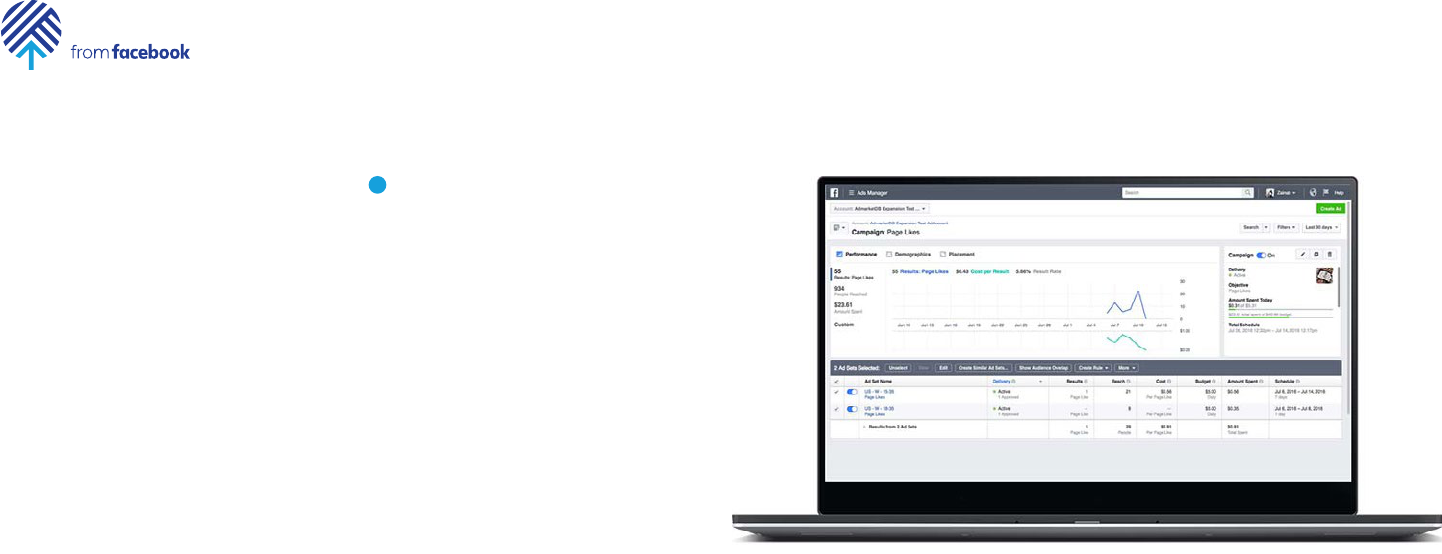
Module 3 Lesson 1: Why Ads? 7
Social Media
Marketing
Why should I buy ads on Facebook?
Facebook’s tools for measuring
and reporting ads are excellent.
With Facebook advertising you
can clearly see what you have
spent and what results it has
provided. You can report on a
range of performance metrics
including the number of times
your ad was shown, the number
of clicks on your ad, and the cost
per click you received.
3

Module 3 Lesson 1: Why Ads? 8
Social Media
Marketing
What are best practices related
to advertising on Facebook?
There are 3 key things to remember
when thinking about advertising on
Facebook:
Be clear about your business
goals before you start.
Know the purpose of your
Facebook Ad before you decide
on a budget. Understand whether
the aim is to increase for brand
awareness, conversions, video
views, etc. Each action made by
your audience on your Facebook
ad costs money, so make sure
you are clear about your goals
before spending the money.
Target your audience specifically.
Take the time to narrow your
audience targeting to make sure
your ad will appear where the
people you want to see it will be.
Rotate your ads regularly.
To avoid ad fatigue, rotate your
Facebook ads regularly. “Ad
fatigue” is when people see your
ad too many times, so they can
get bored and stop clicking.
And, when people stop clicking,
running an ad can get expensive.
1
2
3

Module 3: Lesson 2
The Basics

Module 3 Lesson 2: The Basics 10
Social Media
Marketing
What do I need to start creating an ad?
You will create your ads using Ads
Manager, which is easy to use. There
are five things you’ll need to have
thought about before you start
creating your ad:
Your ad objective
Your target audience
Where you want to place your ad
Your budget and when you’d like
your ad to appear
Your content for the ad
Resources
https://www.facebook.
com/business/learn/
facebook-ads-basics

Module 3 Lesson 2: The Basics 11
Social Media
Marketing
How do I figure out my
ad objective?
We’ve talked before about your
organization’s goals for marketing
on Facebook—are you looking to
create awareness, pique interest, or
get customers? How will this ad help
with those goals?
It is important that you choose the
right objective because your setting
in Ads Manager drives all of the other
choices you will make as you create
your ad.
Resources
https://www.
facebook.com/

Module 3 Lesson 2: The Basics 12
Social Media
Marketing
How do I figure out my
ad objective?
Here is what your choices will look like:
Brand Awareness: Increase
awareness for your brand by
reaching people who are more
likely to be interested in it.
Reach: Show your ad to the
maximum number of people.
Traffic: Send more people to a
destination on or off Facebook.
Engagement: Get more people to
see and engage with your post or
page. Engagement can include
comments, shares, likes, event
responses, and offer claims. You
can chose post, page, or event
responses.
App Installs: Get more people to
install your app.
Video Views: Get more people to
view your video content.
Messages: Get more people
to have conversations with
your business in Messenger to
complete purchases, answer
questions, or offer support.
Lead Generation: Drive more sales
leads, such as email addresses,
from people interested in your
brand or business.
Conversions: Drive valuable actions
on your website or app.
Catalog Sales: Create ads that
automatically show products from
your product catalog based on
your target audience.
Store Visits: Get more people
nearby to visit your brick-and-
mortar locations.
Resources
https://www.facebook.
com/business/

Module 3 Lesson 2: The Basics 13
Social Media
Marketing
What do I need to know about my audience?
How do I target specific groups?
Facebook has great tools for
helping you target your ads to
people who are most likely to
view your ads and take action.
Depending on the ad objective, you
will be guided through selecting
ways to target your ads.
But it’s worth thinking ahead about
a few things before you get started:
Age: Is there an age range of
people you want to target?
Gender: Are you interested in
targeting men, women, or both?
Location: Do you want to reach
folks in your community or in other
parts of the city, state, or country?
Demographics: Will you target
people by education level, income,
or other information?
You’ll learn more about this in
later lessons.

Module 3 Lesson 2: The Basics 14
Social Media
Marketing
What kind of budget do I need?
You’ll want to think about how much
of a budget your organization has for
advertising on Facebook.
If you are new to Facebook ads, it’s
a good idea to keep your budget low
and consider testing different things.
Fortunately, you can do this with a
pretty small budget—sometimes as
low as $15.
When you set a budget, it’s important
to remember that this figure
represents the maximum amount
of money you want to spend. You
can also set your budget to Daily or
Lifetime:
Daily: A daily budget is the average
that you’ll spend every day.
Lifetime: A lifetime budget is the
maximum that you’ll spend during
the lifetime of this advertising
campaign.
You’ll learn more about this in
later lessons.

Module 3 Lesson 2: The Basics 15
Social Media
Marketing
What ad formats are available?
You’ll also want to think about what
your ad will look like before you get
started with the process of creating
it. There are a variety of ad formats
you can use:
Image
Use beautiful images to convey
your message.
Video
Tell your story with sight, sound,
and motion.
Carousel
Show multiple images or videos
in a single ad.
Slideshow
Create lightweight video ads
to connect with people across
connection speeds.
Collection
Tell a story with a single ad that
showcases what you are offering.
Canvas
Build a custom, fast-loading mobile
advertising experience to tell your
story beautifully.
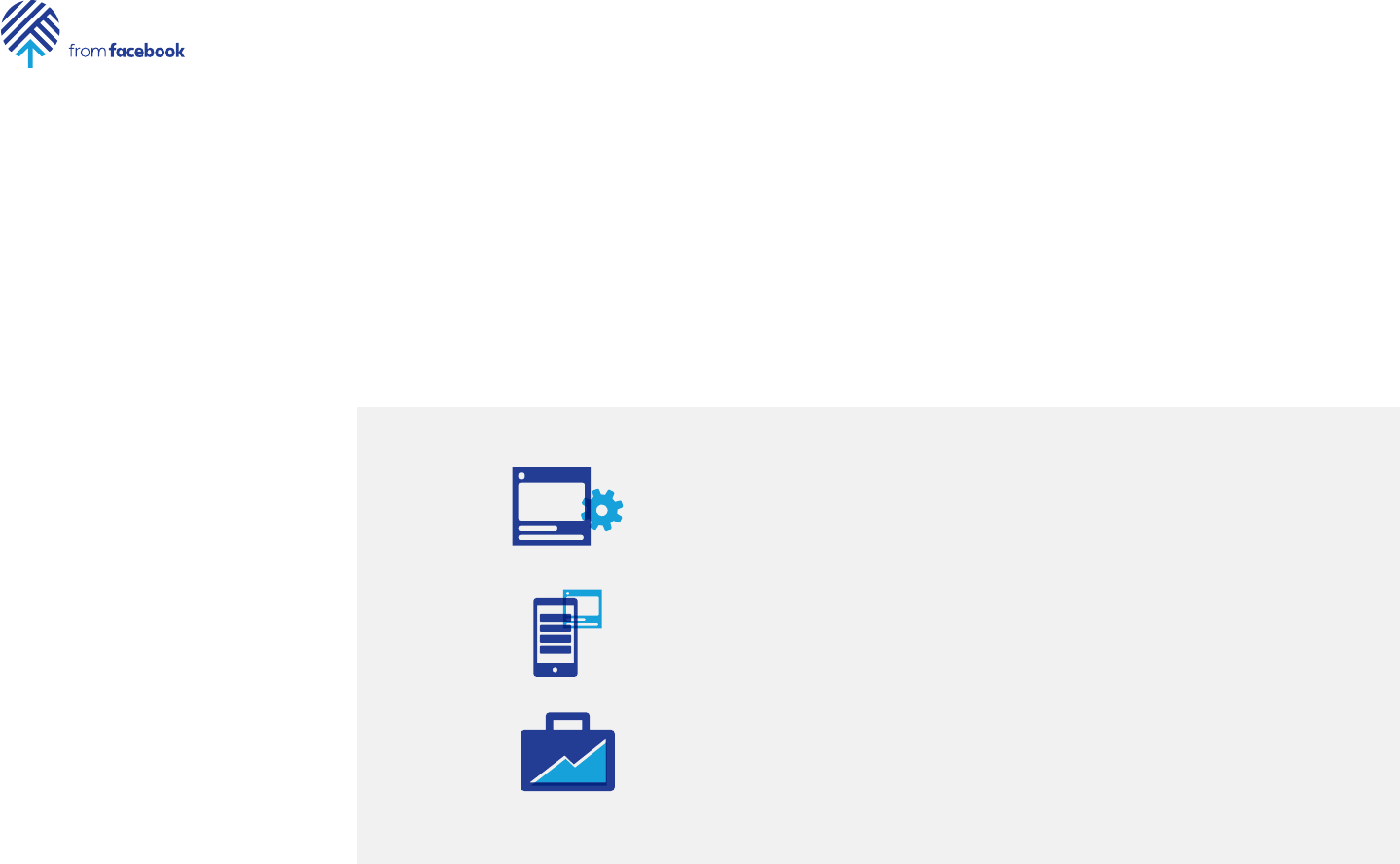
Module 3 Lesson 2: The Basics 16
Social Media
Marketing
How will I manage and measure my ads?
Managing and measuring your ads is
an important part of what you’ll need
to do and Facebook has great tools
to help you do that.
You’ll learn more about Ads Manager
and the Ads Manager App later in
this lesson.
Ads Manager and Business Manager
are more advanced tools and won’t
be covered in this workshop.
Facebook Ads Manager
Quickly create, edit, and manage Facebook ads, all in one place.
This is the tool that works for most people and that you’ll learn
about a little later.
Facebook Ads Manager App
Monitor and control your ads from anywhere using your smartphone
or tablet. We’ll also give you an introduction to this tool a little later.
Facebook Business Manager
Allows businesses to securely share and control access to their
advertising accounts, Pages, and more. This is an advanced tool
and we won’t cover it in this module.

Module 3 Lesson 2: The Basics 17
Social Media
Marketing
Activity: Campaign Objectives
The ad objective drives your entire
campaign on Facebook. As such,
it’s important to think about your
organization’s business goals.
Additional Questions:
What does the Learn More button
tell you about this ad and the
business goal?
What elements of the ad are
compelling and make you want to
learn more?
How might you use a Learn More
button with your organization?
Let’s consider some examples.
Discussion Question:
What do you think the ad objective
was for this ad?
Conversions
Store Visits
Brand Awareness
Traffic
Answer: The ad objective was Brand
Awareness. The idea was to tell the
general public about this organization
and what they do.
Example 1: Ad for Teach for America
Resources
https://www.facebook.
com/business/success/
teach-for-america

Module 3 Lesson 2: The Basics 18
Social Media
Marketing
Activity: Campaign Objectives
Additional Questions:
What about the video ad is
compelling?
Why would this ad work for raising
brand awareness? What do you
learn about their ad?
What function does the slogan
“We live for one, another” have in
the ad?
How might you use some of these
elements in your ads?
Additional Questions:
How does the 360-degree photo
help tell a story about parenting?
How does the question posed on
the ad help draw people in?
In what way does this ad help build
brand awareness?
How might you use stories to
build your organization’s brand
awareness?
Discussion Question:
What do you think the ad objective
was for this ad?
Conversions
Store Visits
Brand Awareness
Traffic
Answer: This ad objective was Brand
Awareness. The idea was to have
people be inspired by the mission of
the company.
Discussion Question:
What ad objective do you think was
chosen for this example?
Conversions
Reach
Brand Awareness
Traffic
Answer: The ad objective was
Brand Awareness. Quaker wanted
to bring awareness to their
#StopCOMPAREnting campaign and
created video ads to draw parents
into the campaign.
Example 2: Ad for Toms Shoes
Example 3: Ad for Quaker Canada
Resources
https://www.facebook.
com/business/success/
toms
https://www.facebook.
com/business/success/
quaker-canada
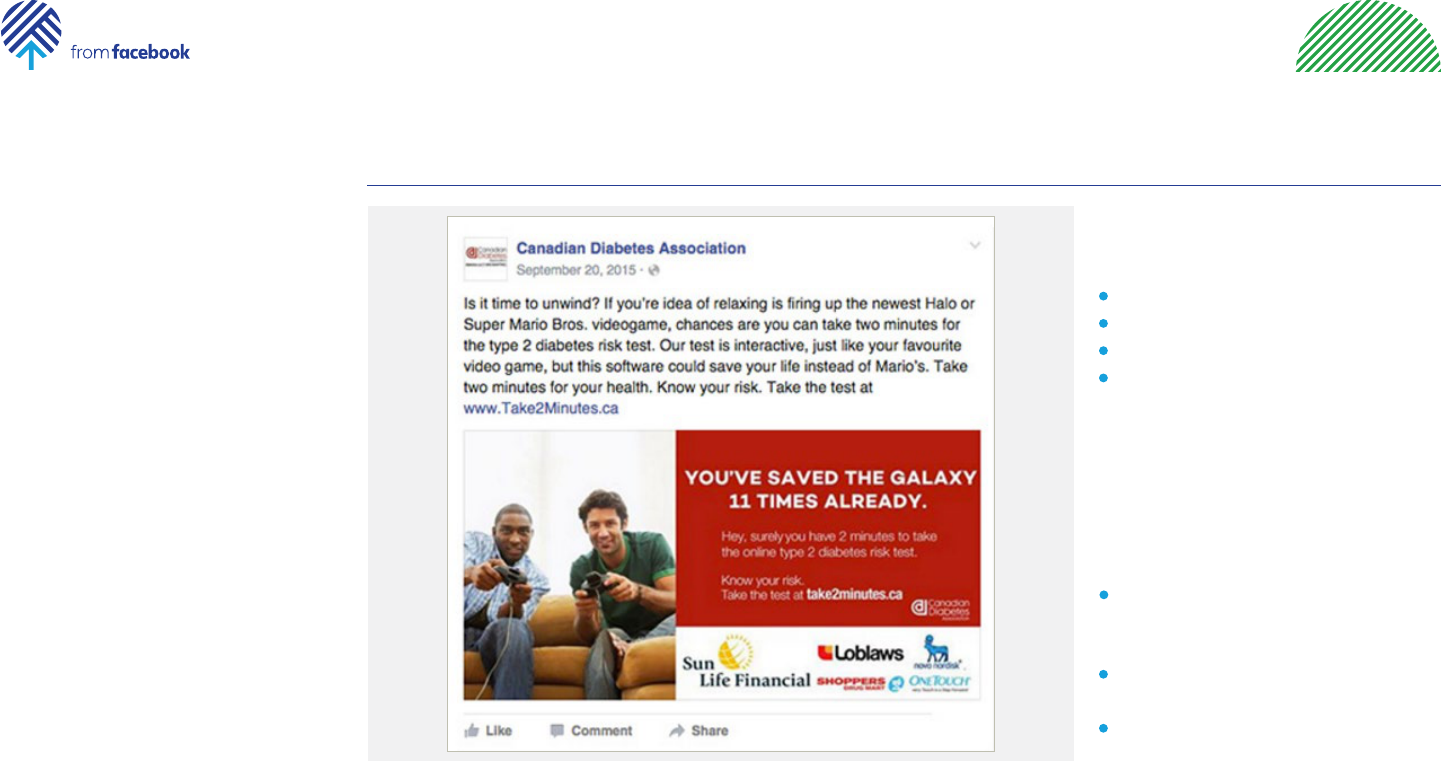
Module 3 Lesson 2: The Basics 19
Social Media
Marketing
Activity: Campaign Objectives
Discussion Questions:
What do you think was the ad
objective for this example?
Conversions
Reach
Brand Awareness
Traffic
Answer: The ad objective was Reach.
The hope was to reach as many
people as possible to share the two-
minute test.
Additional Questions:
How did using a diabetes risk test
help engage and reach a lot of
people? Would you take it? Why?
How can a little education help
engage people?
Are there ways you can find to
help educate people about your
organization?
Example 4: Ad for the Canadian Diabetes Association
Resources
https://www.facebook.
com/business/success/
canadian-diabetes-
association

Module 3 Lesson 2: The Basics 20
Social Media
Marketing
As we said at the beginning of
this lesson, choosing the right ad
objective is key. The first thing you’ll
be asked to do when you create your
ad is to pick an objective.
So in this mini-challenge, you’ll need
to determine the objective of your
first ad.
Mini Challenge: Decide on
Your Ad Objective
Look again at the description of each
objective. Consider each one, talk
with others in your organization,
and decide on the objective for your
first ad.
Write it down. You’ll need it later
when you begin to create your ad.
Discussion Questions
What does “conversion” mean in
terms of my organization’s needs?
What is the ultimate action they
want people to take?
Who is already aware of my
organization’s “brand”?
Who might benefit by knowing
more about my organization?
Do people know about my
organization and what we do?
How can I create an ad that helps
build that awareness?
Can I drive traffic to somewhere
specific like the website or an
event page?

Module 3: Lesson 3
Choose
Audience
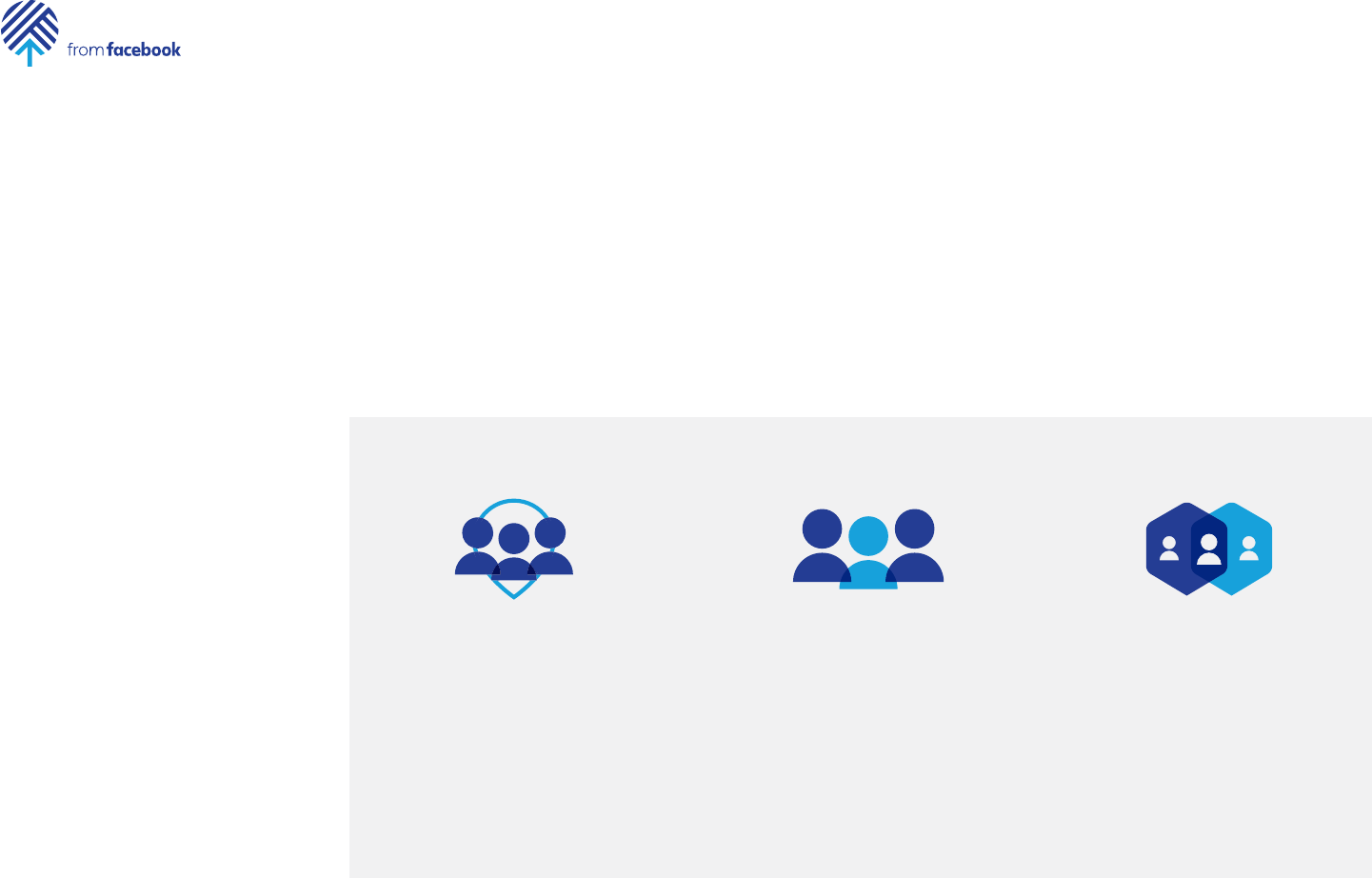
Module 3 Lesson 3: Choose Audience 22
Social Media
Marketing
Who is my audience and
how do I find them?
Your people are here! More than
a billion people use Facebook,
Instagram, and Audience Network
every day. With powerful audience
selection tools, you can target
the people who are right for your
business.
Using what you know about your
customers, such as demographics
and interests, you can connect
with people similar to them. There
are three options for choosing your
audience on Facebook:
Core Audiences
Select your audience manually
based on characteristics, such as
age and location.
Custom Audiences
Upload your customer list to
connect with your customers on
Facebook.
Lookalike Audiences
Use your customer information
to find people similar to them on
Facebook.

Module 3 Lesson 3: Choose Audience 23
Social Media
Marketing
How do I reach people
in my core audience?
Whether you’re a flower shop that
wants more local customers or an
online electronics retailer looking for
people interested in your products,
you can target people based on their
demographics, location, interests, and
behaviors.
Facebook Ads Manager lets you do
this in specific ways.
Location
Reach people in areas where you
want to do business. You might want
to target only people in our local
community. You can do that. You
might want to offer your services to
people all over your state or all over
the country. You can do that. You can
even create a radius around a store
to help create more walk-ins.

Module 3 Lesson 3: Choose Audience 24
Social Media
Marketing
How do I create a Core Audience?
Age and Gender
Consider the age range of the people
you are advertising to. Are you
targeting older men who need auto
repair services? Are you focusing
on women in their 40s who would
be interested in joining your group?
Think about the age range and
gender of the people who are most
likely to engage with you and choose
that range.
Language
Are you targeting Chinese speakers
for your organization? You can you
do that too!
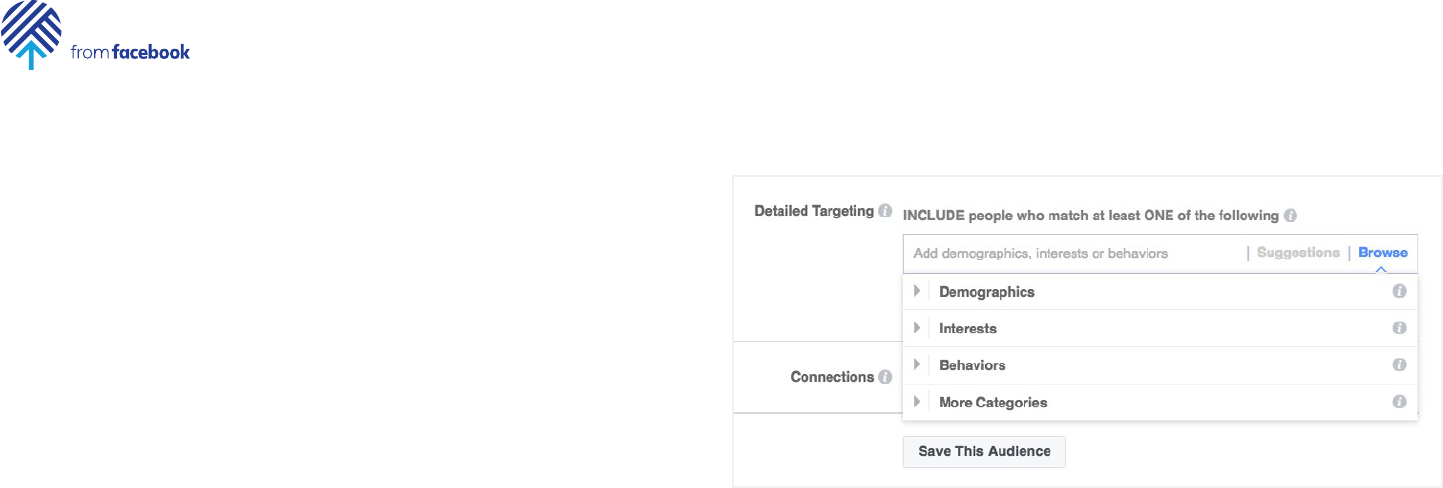
Module 3 Lesson 3: Choose Audience 25
Social Media
Marketing
How do I create a Core Audience?
Detailed Targeting
A really interesting feature of
Facebook is the ability to target
groups by demographics (education,
relationship status, etc.) interests,
behaviors, and more. Here’s where
it really gets powerful. If you want to
tell parents about your daycare, you
can target only parents. If you want
folks interested in biking to see ads
for your bike repair shop, you can do
that! Take some time to explore this
feature—it’ll help you really target
your specific audience.
Connections
Connections allow you to choose
people who have liked your Page(s)
and posts, used your app, or gone
to your event. This feature is a good
way to reconnect with people who
have been with you before.
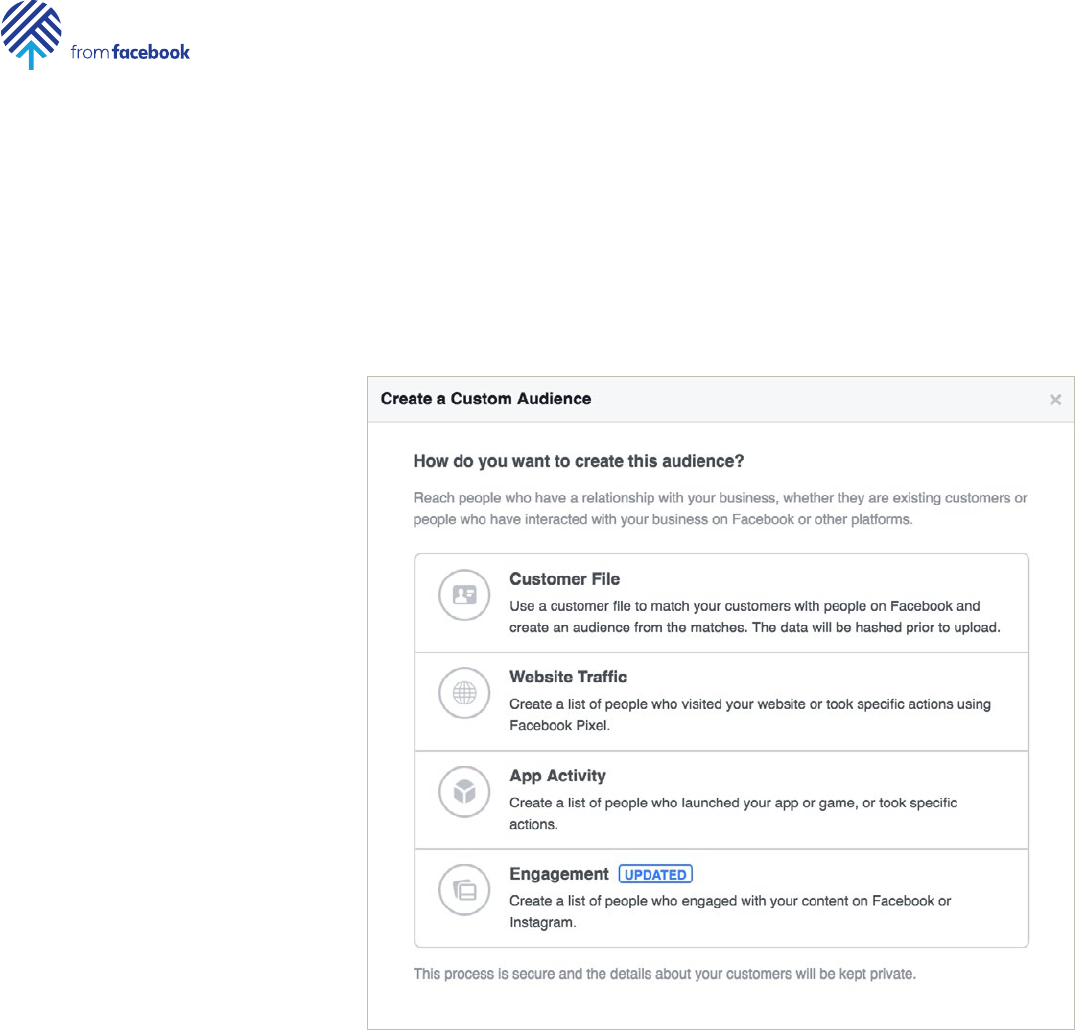
Module 3 Lesson 3: Choose Audience 26
Social Media
Marketing
What is a Custom Audience?
Custom Audiences help you find
your existing customers and
contacts on Facebook. Connecting
with people on Facebook who
already know about your business
can help you build relationships and
drive sales.
Using Ads Manager, you can build
lists of people who have visited your
website, used your app, or engaged
with your posts before.
If your organization has email or other
member lists, this can be a powerful
way of reaching those people
directly! In general, however, this may
be a feature to be used once you’ve
built up your online community.
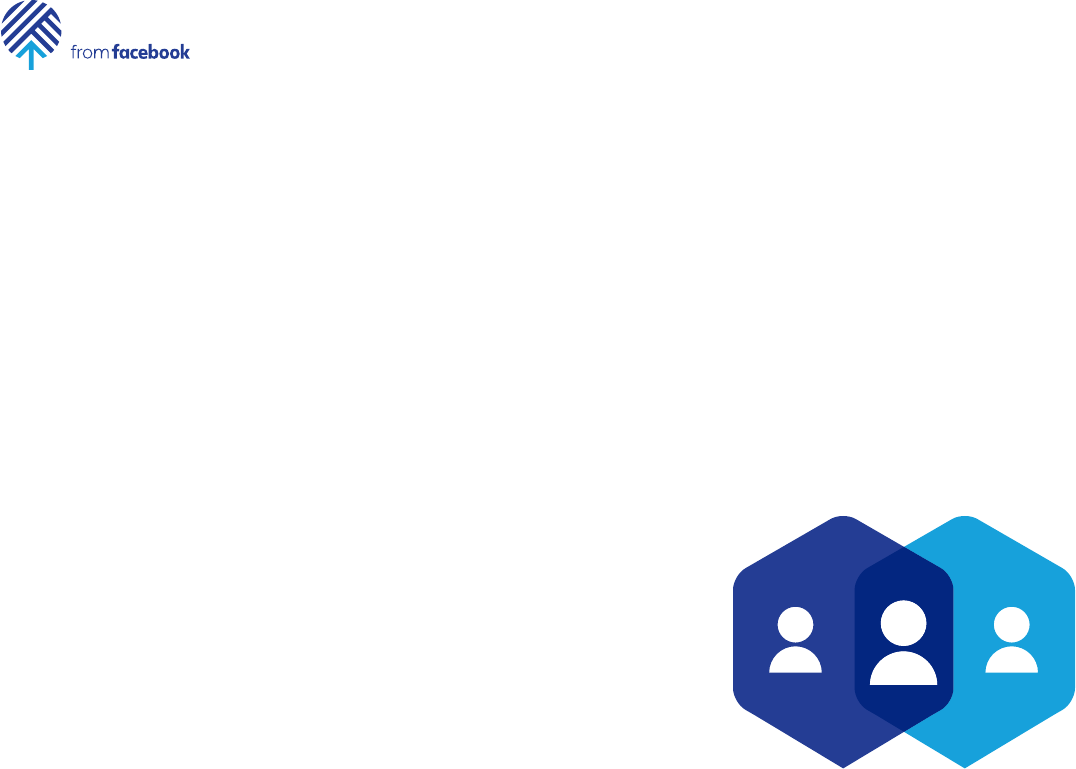
Module 3 Lesson 3: Choose Audience 27
Social Media
Marketing
What is a Lookalike Audience?
Once your Page has been active for
a while, you may want to build your
audience based on people who are
similar to your customers.
Lookalike Audiences helps you
find people on Facebook who are
similar to your existing customers
or contacts. It’s a powerful tool that
uses the insights you’ve gained
from your Facebook marketing and
increases your chances of reaching
people who might be interested in
your business.
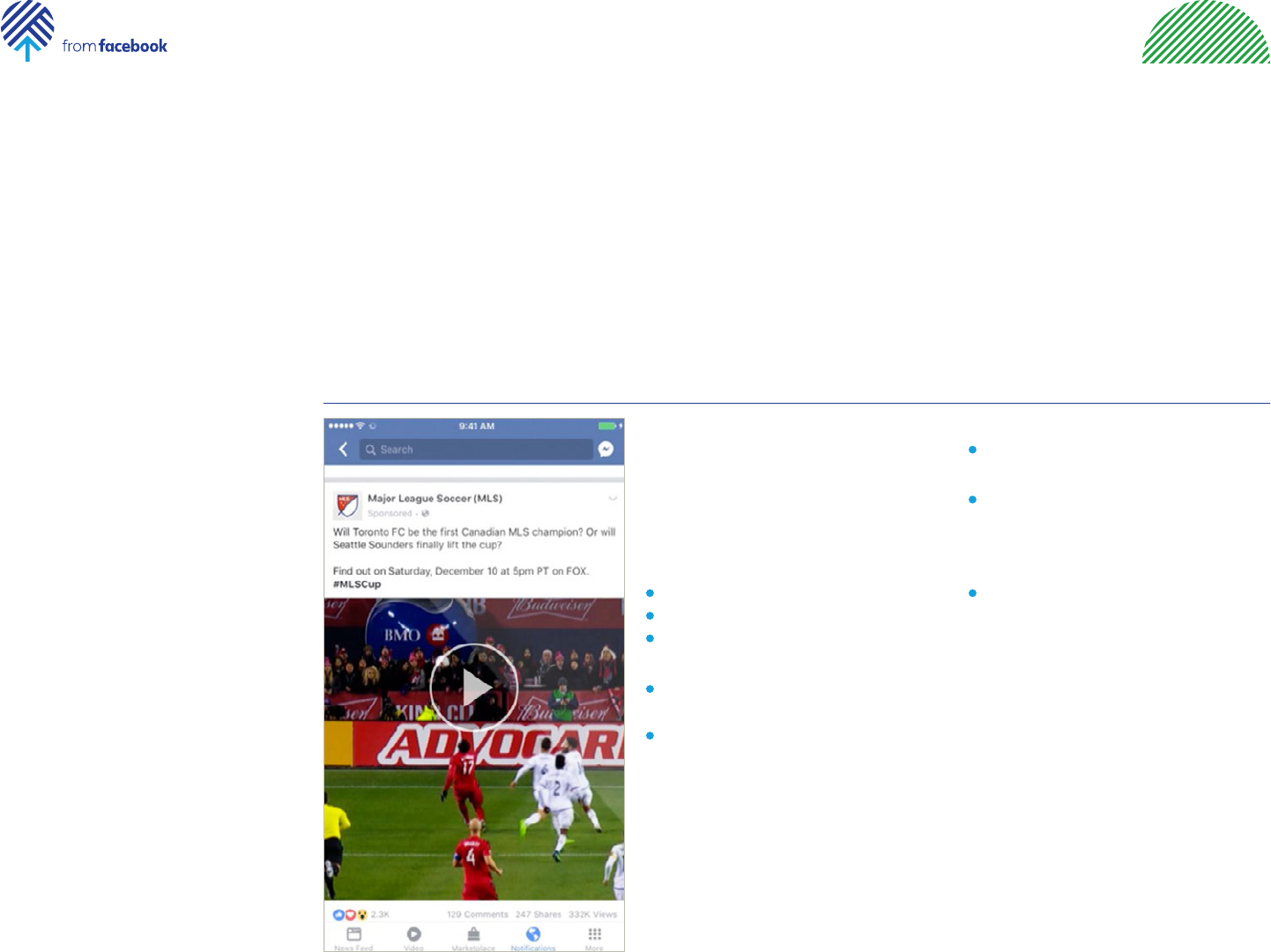
Module 3 Lesson 3: Choose Audience 28
Social Media
Marketing
Activity:
Target Audiences
To take full advantage of Facebook’s
targeting options, you’ll want to
spend time thinking about the
demographics, interests, and
behaviors of your potential audience.
Here are examples from four
organization.
Additional Questions:
What elements of the ad were
tailored to their target audience?
Why is language an important
element in this case? What does
MLS understand about their US
audience?
What other demographics,
interests, or behaviors might you
add here?
Discussion Question:
What can you tell about the
demographics, location, interests, and
behaviors that were considered when
this ad was created?
Answer:
Goal: Raise brand awareness
Gender: Men and Women
Language: English and Spanish
Speakers
Interests: Soccer, Fans of specific
MLS teams
Demographics: Parents of kids who
play soccer
Example 1: Ad from Major League Soccer
Resources
https://www.facebook.
com/business/success/
major-league-soccer
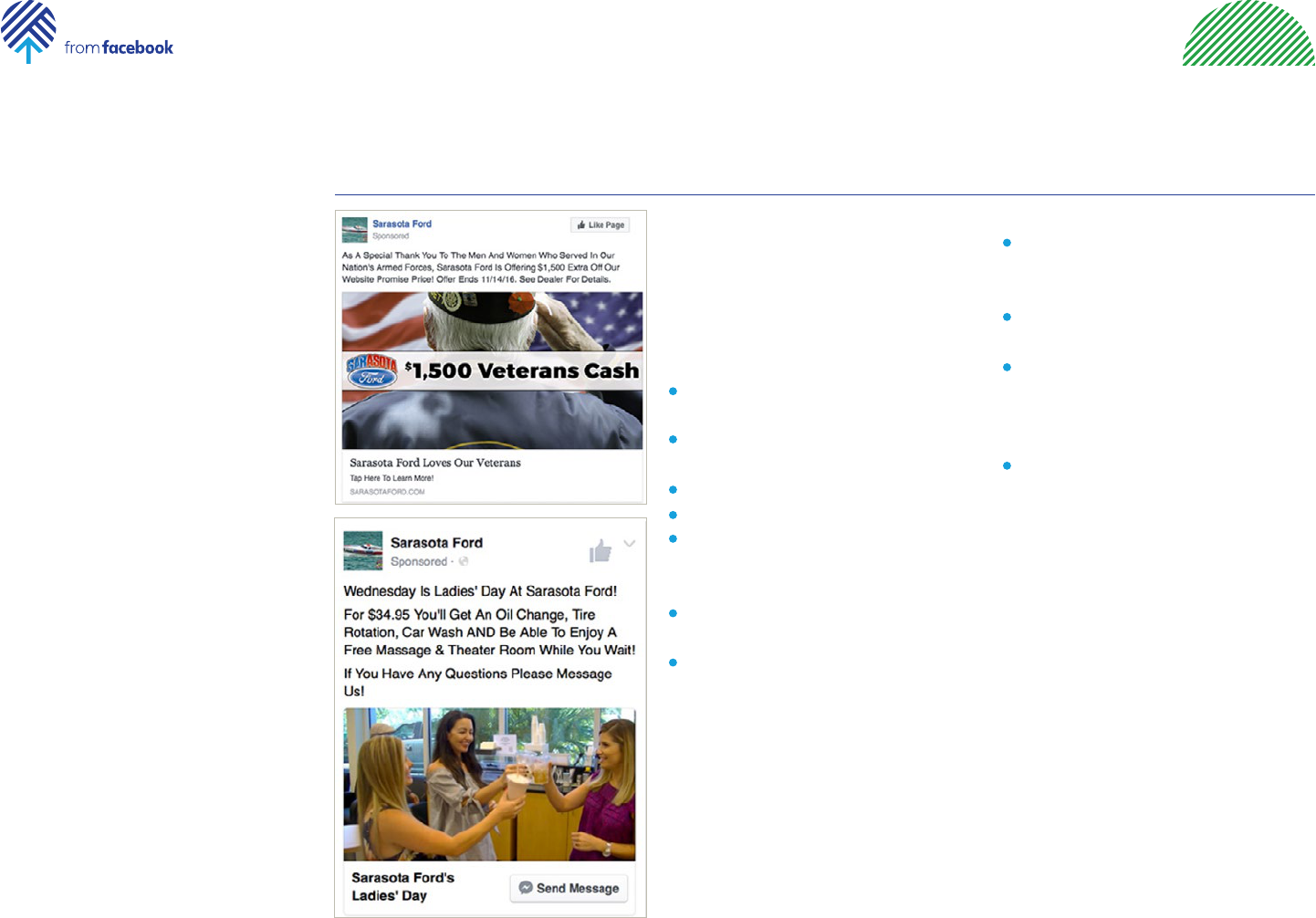
Module 3 Lesson 3: Choose Audience 29
Social Media
Marketing
Activity:
Target Audiences
Additional Questions:
What role did location have in this
ad? Why choose folks living near
the dealership?
Why do you think they picked
Veterans and women to target?
Do you think that targeting people
who were likely to purchase a car
is limiting or do you think it was a
good choice?
Are there any similarities between
your target audience and this
target audience?
Discussion Question:
What can you tell about the
demographics, location, interests, and
behaviors that were considered when
this ad was created?
Answer:
Goal: Increase sales of services
and cars using specific promotions
Gender: Ad 1 - Men and Women,
Ad 2 - Women
Age: Ad 1 - 30+, Ad 2 - 30+
Location: Living near dealership
Interests: Ad 1 - veterans related
groups like Veteran of America,
Ad 2 - cars, specifically Fords
Demographics: Ad 1 - Veterans,
Ad 2 - Car owners
Behaviors: Likely to purchase a
new or used car
Example 2: Ad from Sarasota Ford
Resources
https://www.facebook.
com/business/success/
sarasota-ford#u_0_h

Module 3 Lesson 3: Choose Audience 30
Social Media
Marketing
Activity:
Target Audiences
Resources
https://www.facebook.
com/business/success/
sheetz
Additional Questions:
How does the target audience
of Sheetz match its goals?
What other interests might have
been targeted?
How does location play a role
and why?
Is there something in these ads
that helps you think about your
organization?
Discussion Question:
What can you tell about the
demographics, location, interests, and
behaviors that were considered when
this ad was created?
Answer:
Goals: Increase store visits,
increase sales of food and
beverages
Gender: Men and women
Age: 25-44
Location: Living near stores
Interests: Fast food, fast casual
restaurants
Custom Audience: targeted
audience who liked their Page
Example 3: Ad from Sheetz
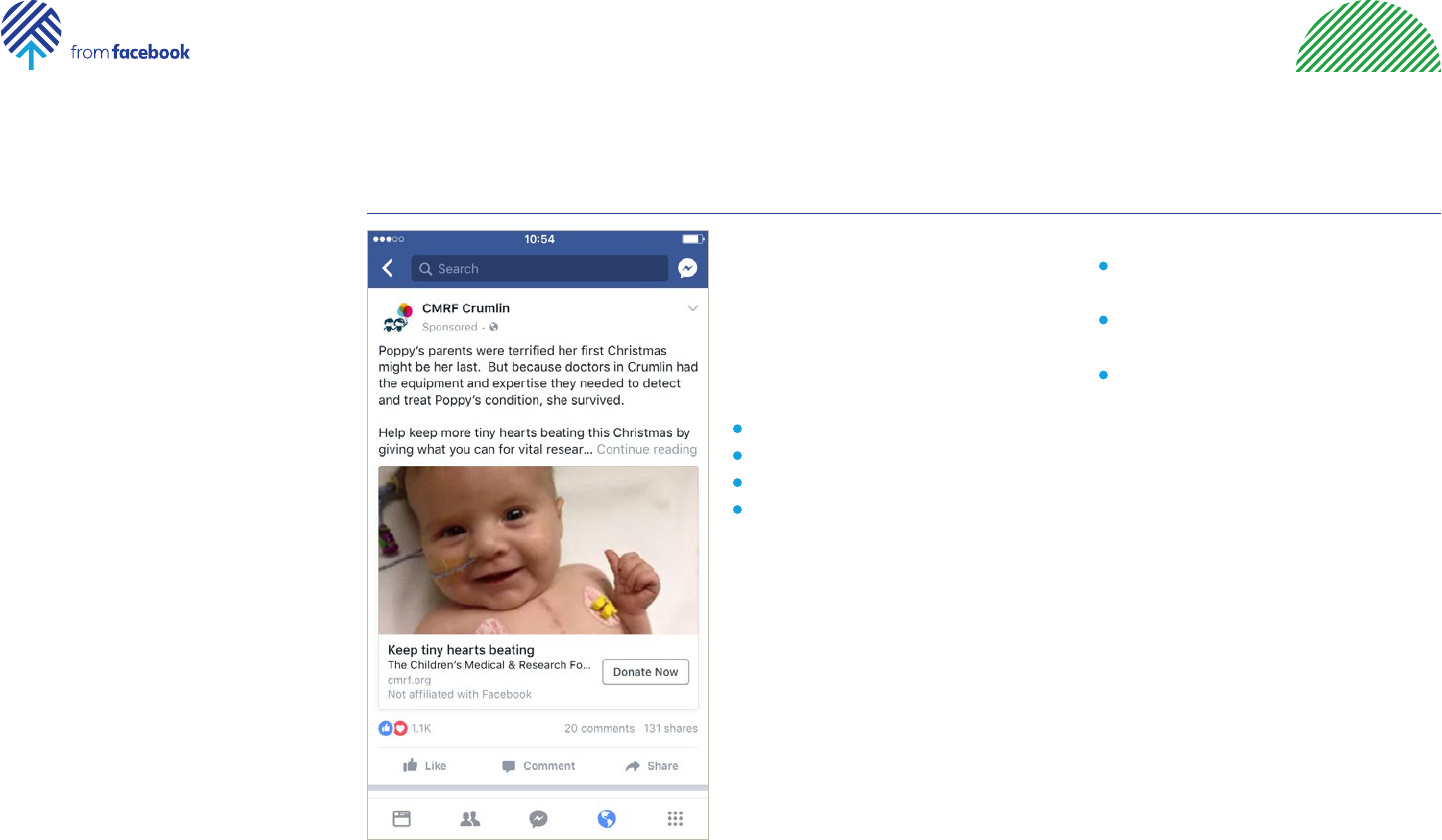
Module 3 Lesson 3: Choose Audience 31
Social Media
Marketing
Additional Questions:
Why might a Custom Audience
be a good idea for this ad?
What about this ad is compelling
to the CMRF’s target audience?
Are there any ideas in this ad
that you can apply to your
organization?
Discussion Question:
What can you tell about the
demographics, location, interests, and
behaviors that were considered when
this ad was created?
Answer:
Goal: Fundraising
Gender: 83% Women
Age: 25-45
Custom Audience: Mothers who
had been treated successfully in
Crumlin
Example 4: Ad from CMRF
Activity:
Target Audiences
Resources
https://nonprofits.fb.com/
story/cmrf-crumlin/

Module 3 Lesson 3: Choose Audience 32
Social Media
Marketing
Using the ad objective you chose
earlier, use this form to think about
each of the ways you can target your
audience.
Don’t worry if it’s not too targeted
at first, you can change and refine
your settings as you run your ad.
Keep the form for later. You’ll want
to refer to it when you are creating
your ad.
Mini Challenge: Think About
Your Target Audience
location
age:
gender:
language:
demographic:
interests:
behaviors:
Discussion Questions:
What have you noticed about
the age and gender of most
of the people involved in your
organization?
What type of person would be very
unlikely to join your organization?
Even if your organization wants
all types of people, what type of
person is most interested?
What would a young person
say was great about your
organization?
What would an older person say
is great about it?
Are those different things?

Module 3: Lesson 4
Ad Placement

Module 3 Lesson 4: Ad Placement 34
Social Media
Marketing
How do I get the widest reach for my ad?
With a few clicks, you can run
ads across Facebook, Instagram,
and Audience Network. The ad
placement options (the places
where you can run ads) let you
grow your reach with precision.
More Places
You will be able to reach people on
their favorite apps and websites
with ads across Facebook,
Instagram, and Audience Network.
Across Devices
You can show your ads on
whichever device your audience
happens to be using, with ad
placement options for mobile
or desktop.
Running ads across platforms and
devices is easy. Just build your
ad once, then select Facebook,
Instagram, and Audience Network
under Placements. No resizing or
reformatting required.

Module 3 Lesson 4: Ad Placement 35
Social Media
Marketing
How do ad placements work?
Through Ads Manager, you can
choose to run your ads across
the Facebook family of apps and
services. This gives the system
more flexibility to get your more
and better results. The different
places your ads are shown are called
“placements.”
The available placements are:
Facebook
Feeds
Instant Articles
In-Stream Videos
Right Column
Suggested Videos
Marketplace
Instagram
Feed
Stories
Audience Network
Native, Banner, and Interstitial
In-Stream Videos
Rewarded Videos
Messenger
Home
Sponsored Messages
There are two approaches to using
placements: automatic and manual.
Most people will use the automatic
placement that allow Facebook to
optimize placements across the
system.

Module 3 Lesson 4: Ad Placement 36
Social Media
Marketing
Should I use Automatic Placements
or manually choose them myself?
Facebook recommends using the
automatic placements option, which
basically tells our system to find
the most relevant people and cost-
effective results available across all of
these placements.
The ad delivery system is designed
to get you the most results at the
lowest average cost overall—not
the lowest average cost for each
placement. It will look at placements
on Facebook, Instagram, Audience
Network, and Messenger and choose
the specific placements in each that
are the most relevant to your ad
objectives, audience selections, and
other settings.
Resources
https://www.facebook.
com/business/
help/965529646866485
https://charlielawrance.
com/the-ultimate-
guide-to-facebook-ad-
placement/
Taking advantage of every
placement is the most efficient use
of your budget.
You can also choose your
placements manually, using the Edit
Placements option. Generally, though,
doing this involves understanding
a lot about your audience and their
behaviors and is a more advanced
set of skills than we cover in this
workshop.

Module 3: Lesson 5
Budget and
Schedule

Module 3 Lesson 5: Budget and Schedule 38
Social Media
Marketing
How does the auction system work?
Facebook uses an auction as a basis
for their ads system. The auction can
seem complicated, but it is important
to have general sense of how it works
before you create an ad and set a
budget.
Overall, when showing ads, Facebook
tries to balance two things:
Help advertisers reach their
prospective audiences
Make sure Facebook users have
a positive experience
To do this, they hold an auction that
takes both things into account. That
way, advertisers are reaching people
receptive to their ads and users are
seeing something they’re interested
in. The goal is to match the right ad to
the right person at the right time. This
is different from a traditional auction
because the winner isn’t the ad with
the highest monetary bid, but the ad
that creates the most total value.
The ad that wins an auction and gets
shown is the one with the highest
total value. Total value isn’t how
much an advertiser is willing to pay
to show their ad. It’s a combination
of 3 major factors: the advertiser
bid, the estimated number of clicks
or purchases (or other action)
the system estimates the ad will
generate, and the quality and the
relevance of the ad to the person
who will see it.
An auction takes place whenever a
Facebook user is eligible to see an
ad. The “participants” in an auction
are ads targeted to an audience the
eligible person falls into. Billions of
these auctions take place everyday.
To learn more about how the auction
works, see Resources.
1
2
Resources
https://www.facebook.
com/business/
help/430291176997542
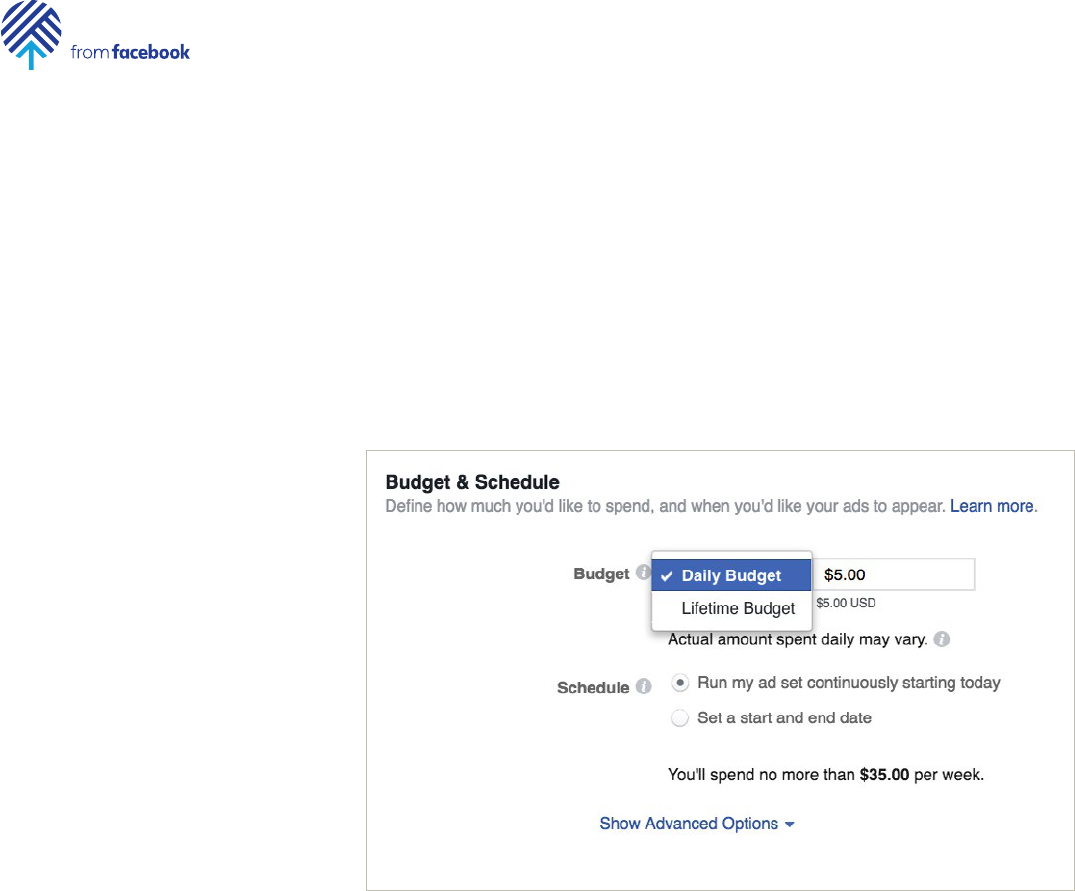
Module 3 Lesson 5: Budget and Schedule 39
Social Media
Marketing
Should I use a Daily budget
or a Lifetime budget?
When you buy ads on Facebook,
there are two ways to set your
budget:
Daily Budget
Your ad runs until your maximum
budget is met each day, for a pre-
specified number of days.
Lifetime Budget
Your ad runs continuously until a
maximum amount is reached, or
the advertising end date arrives.
A daily budget gives you the most
control, since you know exactly how
much you’re spending each day. With
a lifetime budget, your spend will
vary from day to day. Both models
can be adjusted or terminated at any
time, so as long as you’re keeping
a close eye, you don’t have to worry
about unexpected charges.
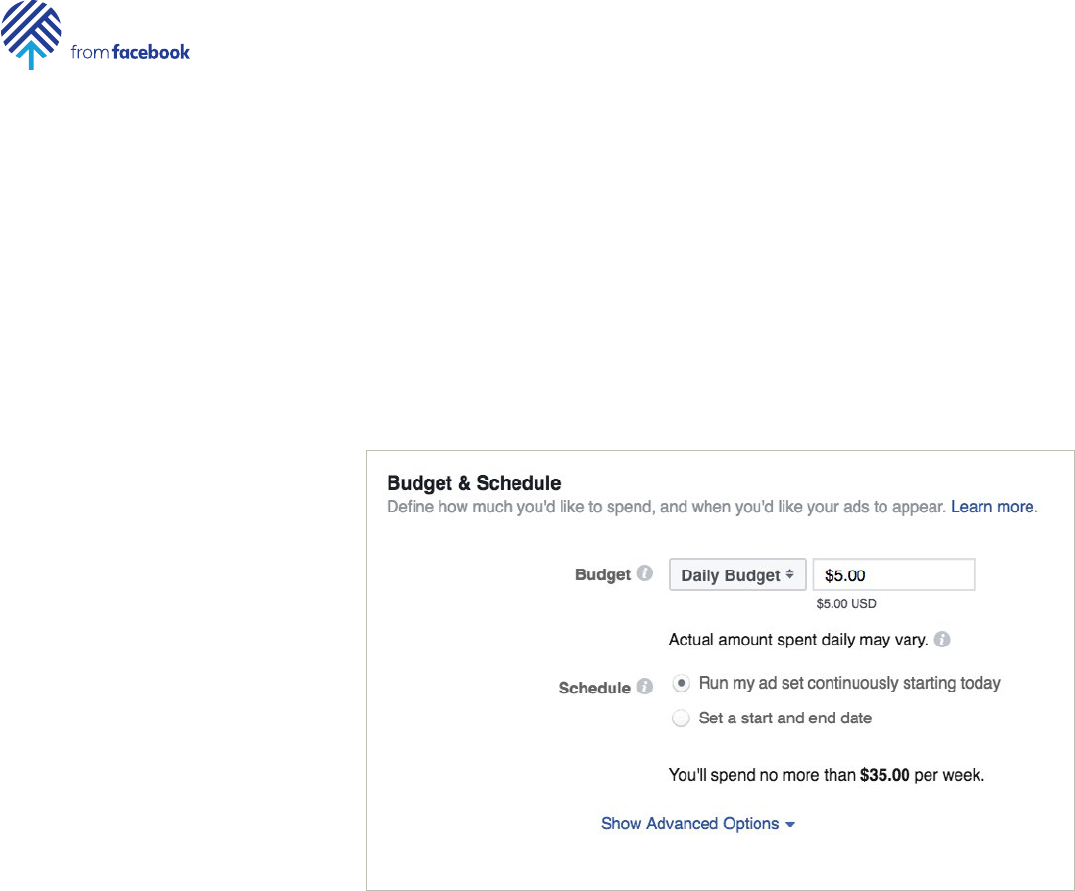
Module 3 Lesson 5: Budget and Schedule 40
Social Media
Marketing
How do I set my bid?
Once you’ve decided on how much
you want to spend, the next step
is to determine your bid. This is the
amount you’re willing to pay for
deployment of your ad.
Facebook will automatically suggest
a bid amount based on your industry
and audience. This is usually a
reliable estimate, so if you don’t feel
like playing around with bids, you can
leave this as is.

Module 3 Lesson 5: Budget and Schedule 41
Social Media
Marketing
What happens when I
increase or lower my bid?
One thing to keep in mind is how
adjusting your bid amount will
affect your ad performance. Don’t
forget that you are competing with
other advertisers who are trying to
reach the same audience. The more
competition for the ad, the higher the
suggested bid.
Increasing the bid improves the odds
of your ad getting shown. You should
think about this if your ad isn’t getting
shown often enough to reach your
daily budget.
Lowering the bid decreases the odds,
AND it means you’re paying less
per click. Lowering the bid might be
smart if you’re reaching your daily
budget a lot and want to spread
your dollars further. Just be careful—
bidding too low may drop views of
your ad altogether.

Module 3 Lesson 5: Budget and Schedule 42
Social Media
Marketing
Can I control the schedule
and delivery of my ad?
There are two things to pay attention
to as you think about scheduling
your ad:
Schedule
You can choose to have your ad run
continuously. Your ad will be eligible
to start running after Facebook
reviews and approves it. The review
process typically takes up to 24
hours, although in some cases it may
take longer. If you’ve scheduled your
campaign to start immediately, it’ll
start running once it’s been reviewed.
You can also schedule your ad to
start at a specific date and time for
a specific period of time.
Delivery
There are two pacing options
available for ad delivery: lowest
cost or target cost. The choice is
called “Bid Strategy,” and it’s made
in the “Budget & Schedule” section
at the ad set level when creating a
Facebook campaign.
Lowest cost: This tells Facebook to
bid with the goal of getting you the
lowest possible cost per optimization
event while also spending your entire
budget by the end of the day or your
ad set’s (or campaign’s) lifetime
(depending on its budget type—daily
or lifetime). You can also set a “bid
cap,” which tells us the maximum
amount we can bid in an auction.
Target cost: This tells Facebook
to bid with the goal of achieving
an average cost per optimization
event as close to your cost target
as possible. This strategy is only
available when using the following
objectives: Lead Generation, App
Installs, Conversions, or Catalog
Sales.

Module 3 Lesson 5: Budget and Schedule 43
Social Media
Marketing
Now is the moment to think about
what your budget for this first ad
will be.
You’ll want to discuss an amount
with your contacts at the
organization. Consider starting with
something fairly low—maybe $15.
Also consider whether you want
to set a Lifetime Budget or a Daily
Budget.
Mini Challenge:
Budget and Schedule
Lastly, you’ll want to think about
the scheduling. For this workshop,
it will be best to start the ad run
immediately.
Write down your budget amount to
enter later when you begin to create
your ad.
budget:

Module 3: Lesson 6
Create
Your Ad

Module 3 Lesson 6: Create Your Ad 45
Social Media
Marketing
How do I create single-image ads?
Whatever your business goals are,
a single-image ad on Facebook or
Instagram is a great way to increase
awareness of who you are and what
you do.
An image in an ad gives you a clean,
simple format to use with an inspiring
visual and engaging copy.
This basic format is the most popular
format especially for organizations
that are new to Facebook and are still
learning about what works and what
doesn’t.
Creating an image ad is similar to
creating a simple Page post with
a photo. With Ads Manager, you’ll
upload a great photo and add
engaging text.
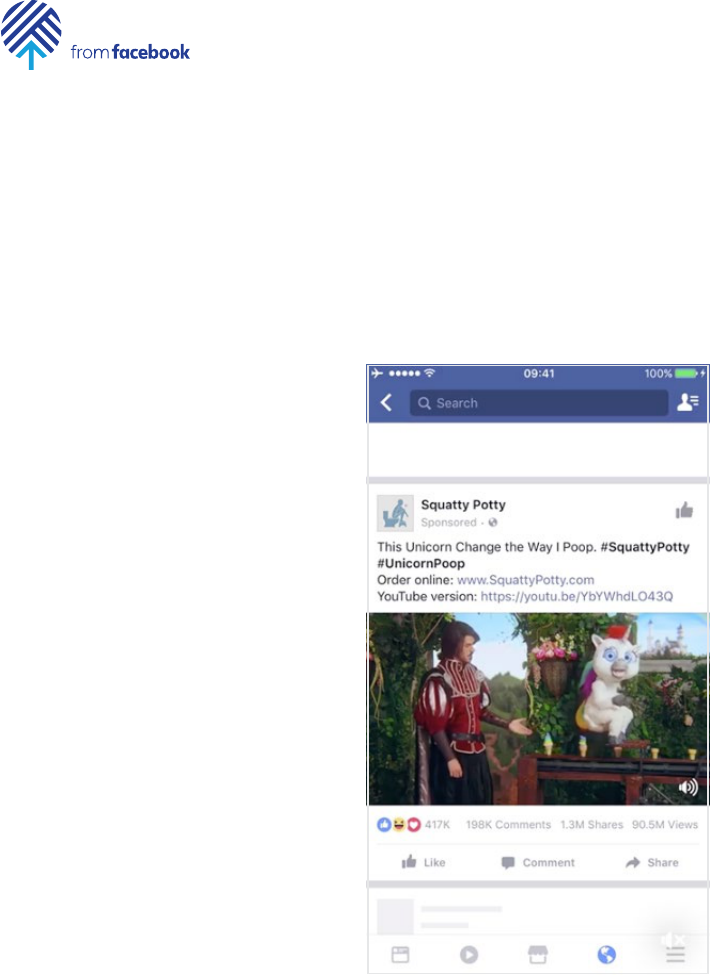
Module 3 Lesson 6: Create Your Ad 46
Social Media
Marketing
How do I create video ads?
Over 100 million hours of video are
watched every day on Facebook—
that’s more video than you could
watch in 11,000 years. The video
advertising options on Facebook,
Instagram, and Audience Network
are designed to reflect the way
people actually consume video—
from bite-sized videos they watch
on the go, to longer video styles they
watch on the couch.
You’ll want to use video to make a
memorable human connection with
your viewers. Use it to tell stories,
to show how people are using your
products or services, to show the
impact of your work, and to help
people understand who you are as
an organization. You can build trust
and connections with your audience
this way.
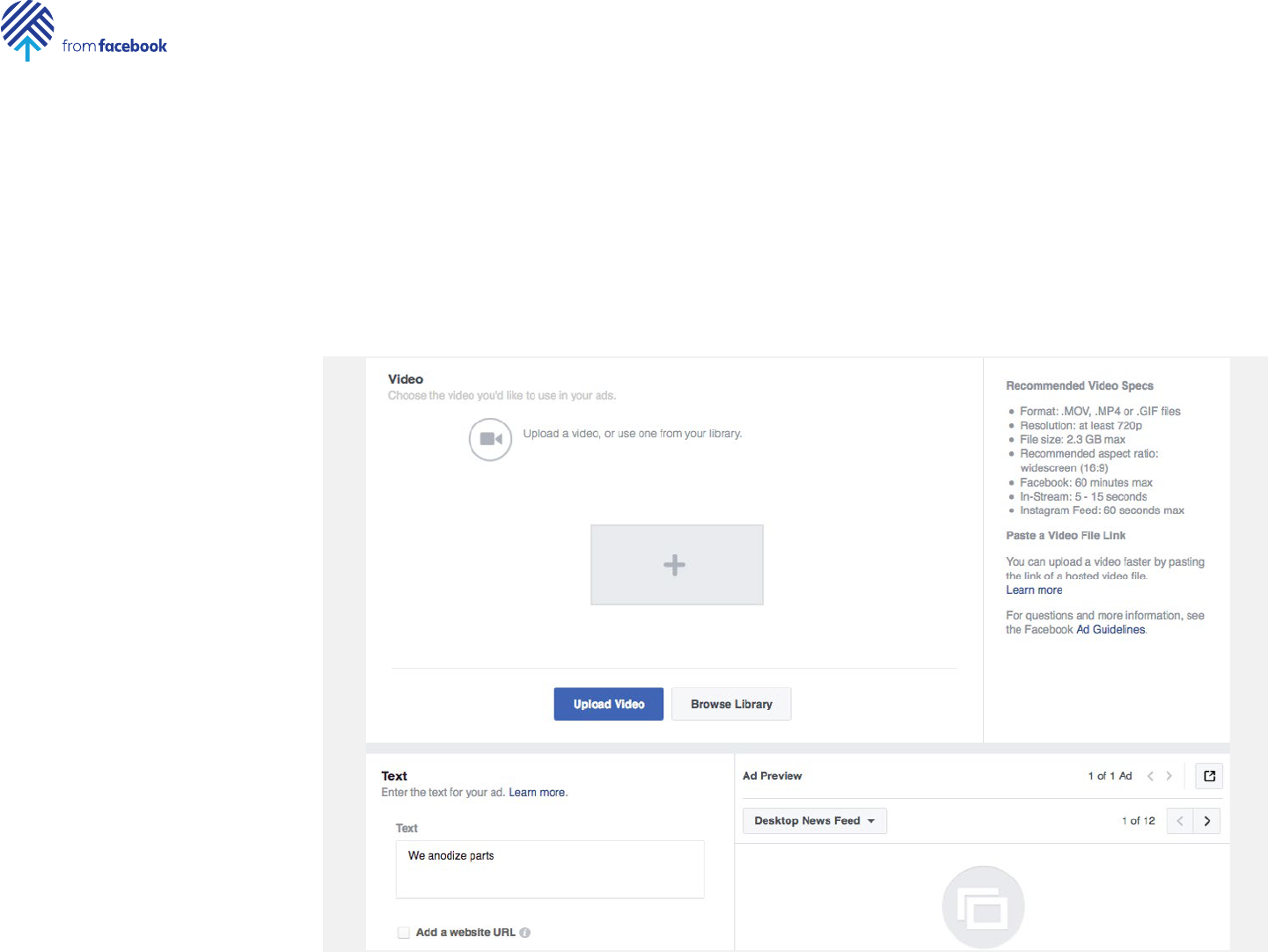
Module 3 Lesson 6: Create Your Ad 47
Social Media
Marketing
How do I create video ads?
Creating a video ad is similar to
posting a video to your Facebook
Page. Using Ads Manager, you’ll
upload a video and add engaging
text. You can also create a video ad
right from your Facebook Page by
publishing and boosting a post with
an image.
To learn more about the best video quality,
acceptable formats, and aspect ratios, see
Resources.
Resources
https://www.facebook.
com/business/
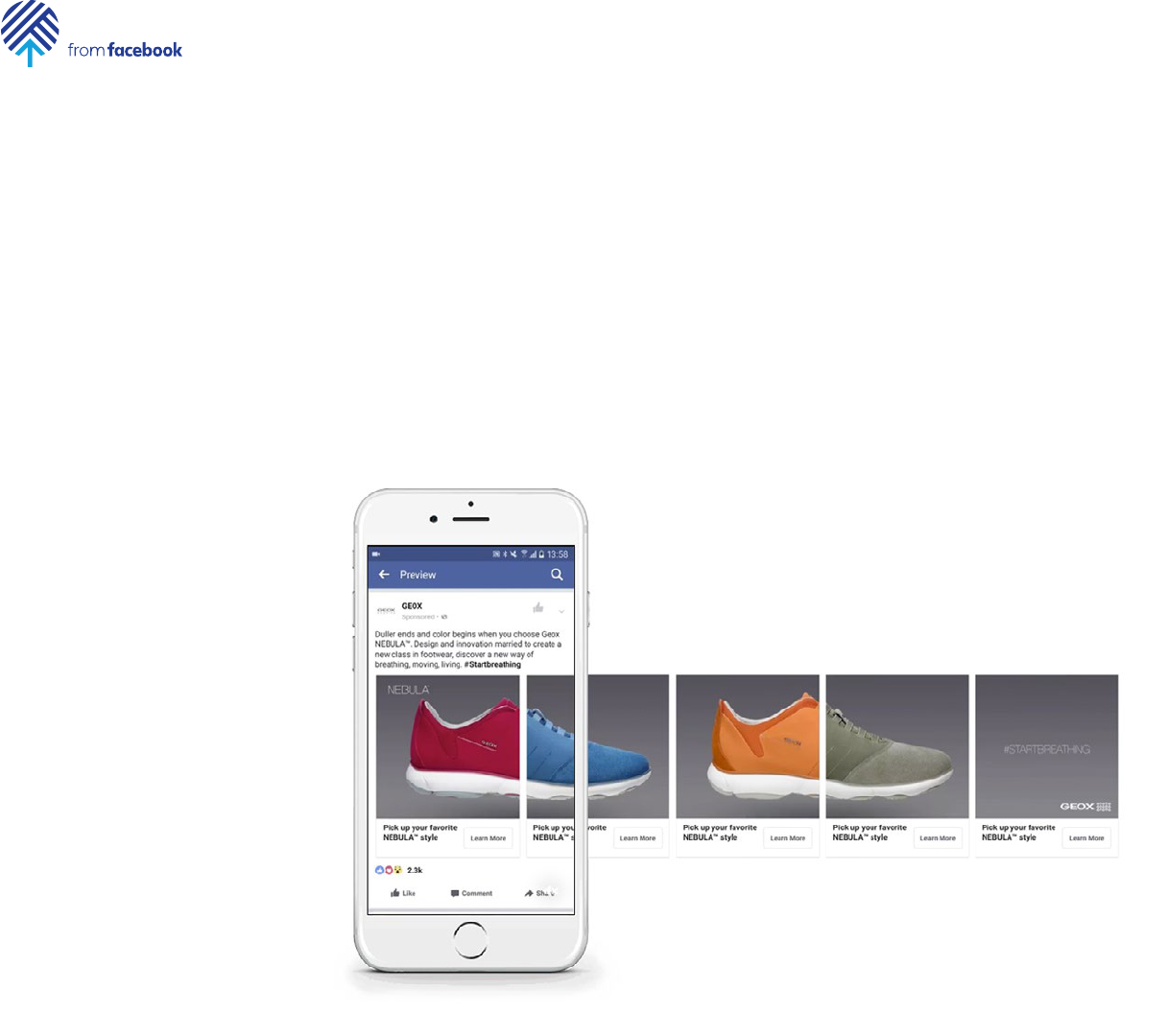
Module 3 Lesson 6: Create Your Ad 48
Social Media
Marketing
How do I create carousel ads?
The carousel format allows you to
showcase up to 10 images or videos
within a single ad, each with its own
link. With more creative space within
an ad, you can highlight different
products, showcase specific details
about one product, service or
promotion, or tell a story about your
brand that develops across each
carousel card. The ad format can be
used by any business to accomplish
a variety of advertising objectives.
When should you use carousel ads?
This format is a good way to start
using more complex formats for your
ads. If you’re selling products, you
can use them to show off several
of your products at once, or show
different views of the same product.
If you’re promoting an event, you can
show several pictures of last year’s
event. You can tell your company’s
story or visually explain how you have
made a difference for a client.
The key advantage to this format
is that you can put a call-to-action
on each card of the carousel. This
means you have the potential to get
multiple clicks from one ad!

Module 3 Lesson 6: Create Your Ad 49
Social Media
Marketing
How do I create carousel ads?
Here are some ways to use the
carousel format:
Show Multiple Products
Give customers more options and
encourage them to purchase by
showing a different product on each
carousel card, with links to different
landing pages.
Highlight Different Features of a
Single Product
Use each carousel card to show
different product angles or details to
better inform customers.
Tell a Story
Use images or videos in succession
to illustrate a compelling narrative.
Explain a Process
Walk people through how your
business works step by step.
Creating a carousel ad is easy. You’ll
select up to 10 images or videos, add
text for each, and post them as a set.
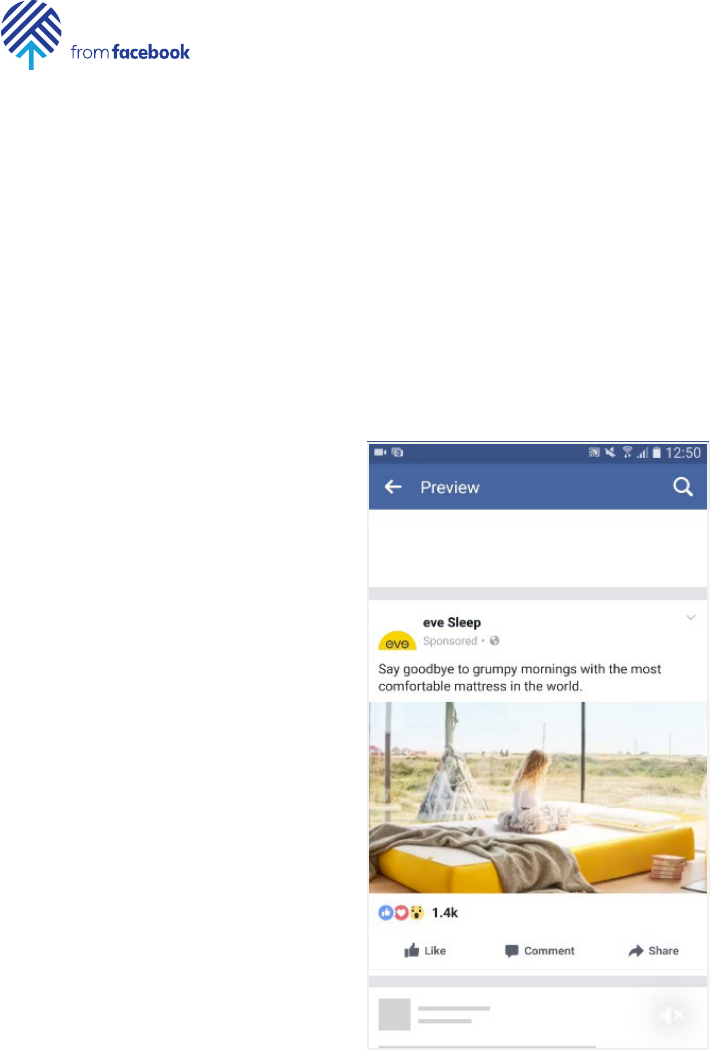
Module 3 Lesson 6: Create Your Ad 50
Social Media
Marketing
How do I create slideshow ads?
Slideshow ads give you the power of
video, without the time and expense.
Facebook slideshow ads are video-
like ads that use motion, sound and
text to tell your story beautifully
across devices and on every
connection speed. You can create a
slideshow ad in minutes and use it to
tell a story that develops over time.
You can even create a slideshow ad
out of stock images available in Ads
Manager or use an existing video.
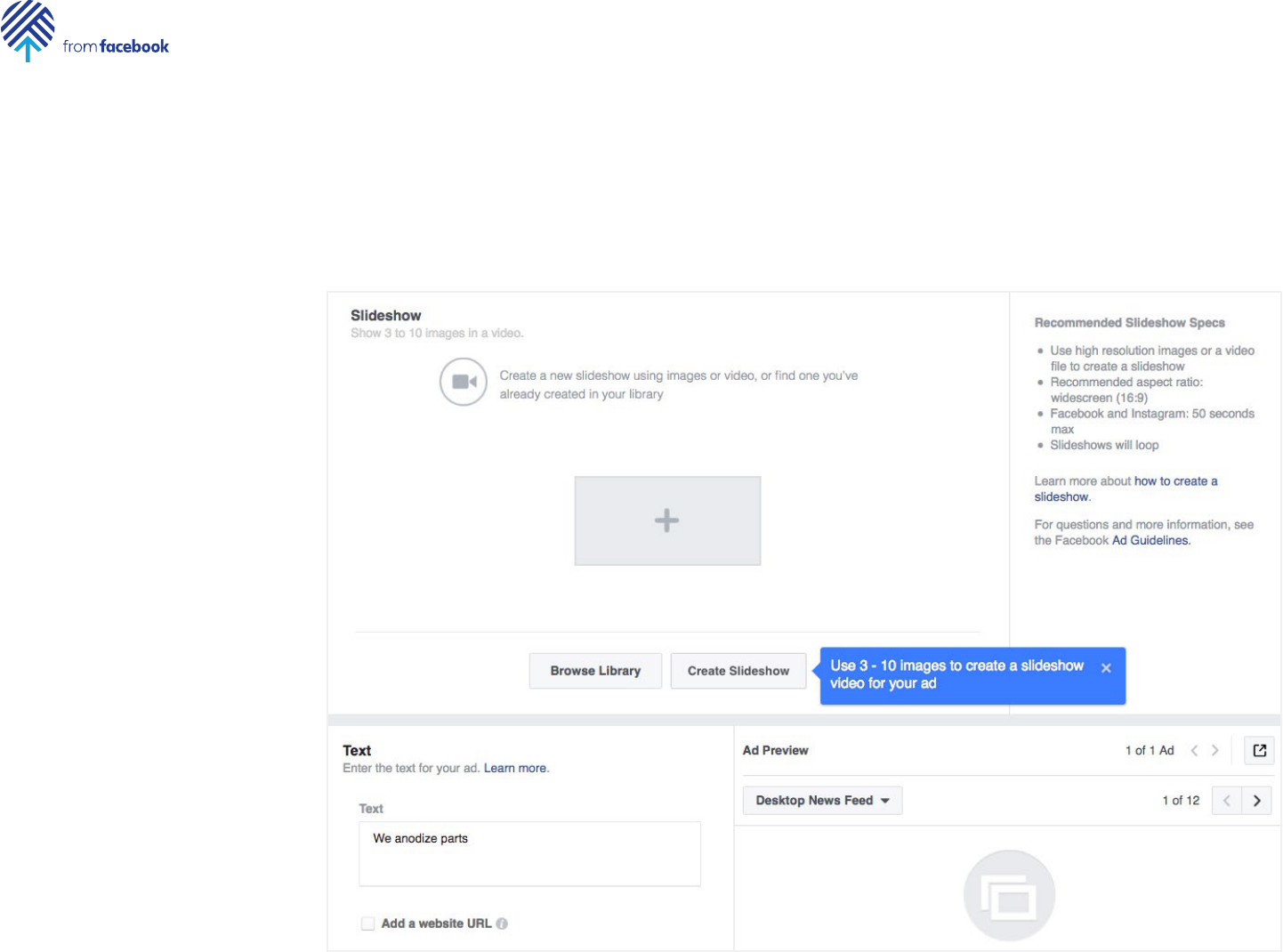
Module 3 Lesson 6: Create Your Ad 51
Social Media
Marketing
How do I create slideshow ads?
You can think about using slideshow
ads instead of video ads if you don’t
already have a video. You can also
think about slideshow ads instead
of carousel ads if you have a series
of images that string together to tell
a good story.
Creating a slideshow ad is easy. You’ll
select up to 10 images or a video and
automatically create a slideshow.
You can also add text, transitions,
and music.

Module 3 Lesson 6: Create Your Ad 52
Social Media
Marketing
How do I create collection ads?
Collection is an ad format that makes
it easier for people to discover,
browse, and purchase products and
services from their mobile device
in a visual and immersive way. With
collection, people who tap on your ad
can browse more products or learn
more about the features of a specific
product, in a fast-loading, full screen
experience, without leaving the
Facebook app.
A collection ad has a “lead” video
or image, followed by four product
images below. If someone taps on
the ad, it opens up a broader catalog
of up to 50 different products. Then if
they tap on a specific product, they’ll
go to the advertiser’s website or app
to make the purchase.
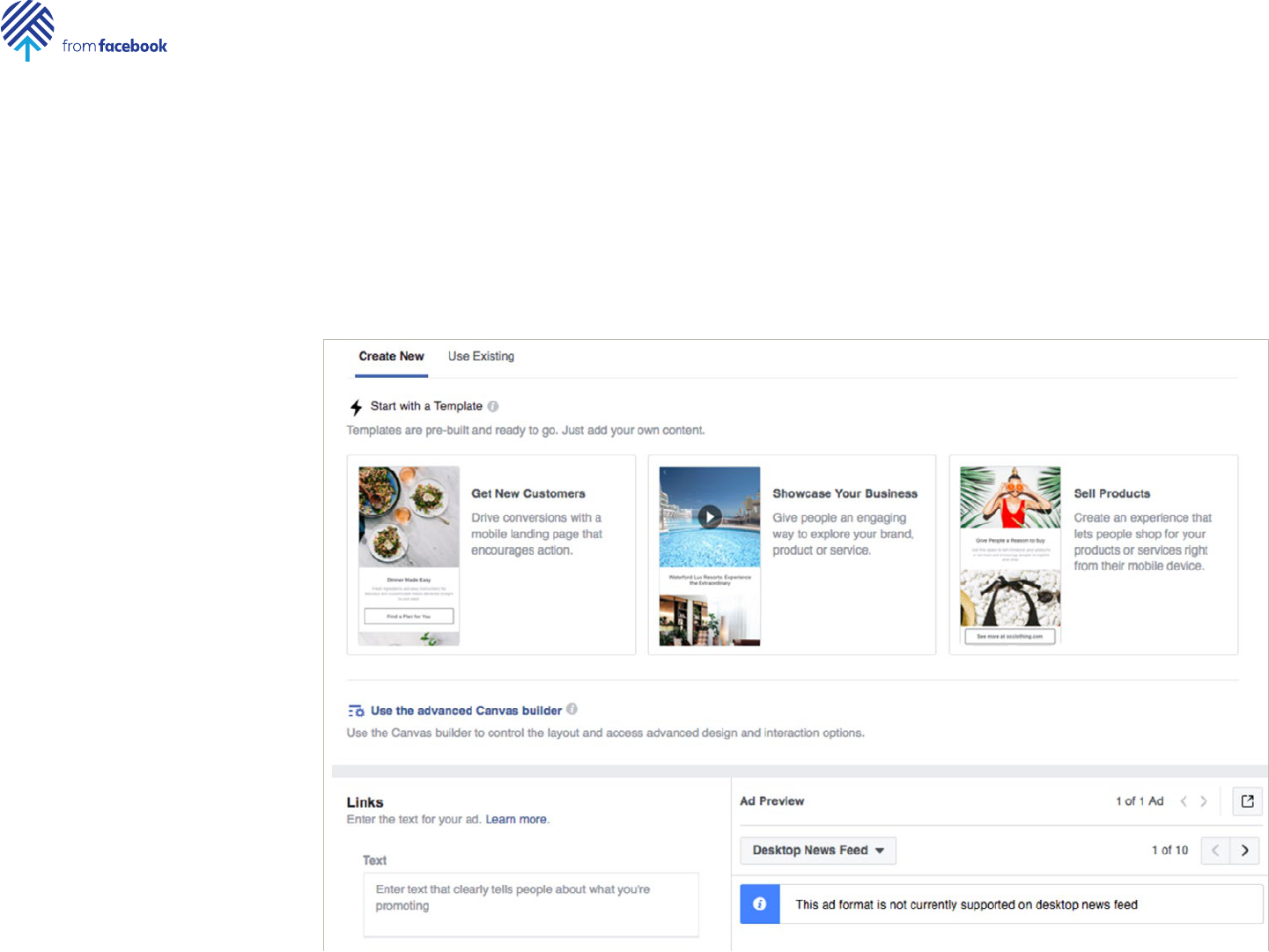
Module 3 Lesson 6: Create Your Ad 53
Social Media
Marketing
Creating a collection ad can be done
through Ads Manager. You’ll select
the photos you want to use and add
the URLs on your website that you
want each photo to go to.
How do I create collection ads?

Module 3 Lesson 6: Create Your Ad 54
Social Media
Marketing
What is a Canvas and how
do I create ads with it?
Canvas is a powerful tool that allows
you to build custom ads for various
purposes. For the purposes of this
workshop, we’ll describe how it works
and when to use it. A more advanced
discussion of it is out of the scope of
this workshop.
Canvas is a fullscreen experience for
mobile devices. It can be used with
all Facebook ad formats—carousel,
single image, single video, slideshow,
or collection.
The easiest and quickest way to
build a Canvas is with templates. You
can find Canvas templates in Ads
Manager or Power Editor. Canvas
templates are perfect if you are new
to Canvas or have limited time to
create your ads.
There are three simple templates
to choose from. Each template is
optimized for a business goal:
Sell products
Shows features and benefits of your
products or services to inspire mobile
shopping from your online catalog.
Showcase your business
Drives awareness of your brand and
educates people through Canvas
storytelling—a powerful way to
engage your audience.
Get new customers
Brings your landing page to Canvas,
and highlights the features and
benefits.
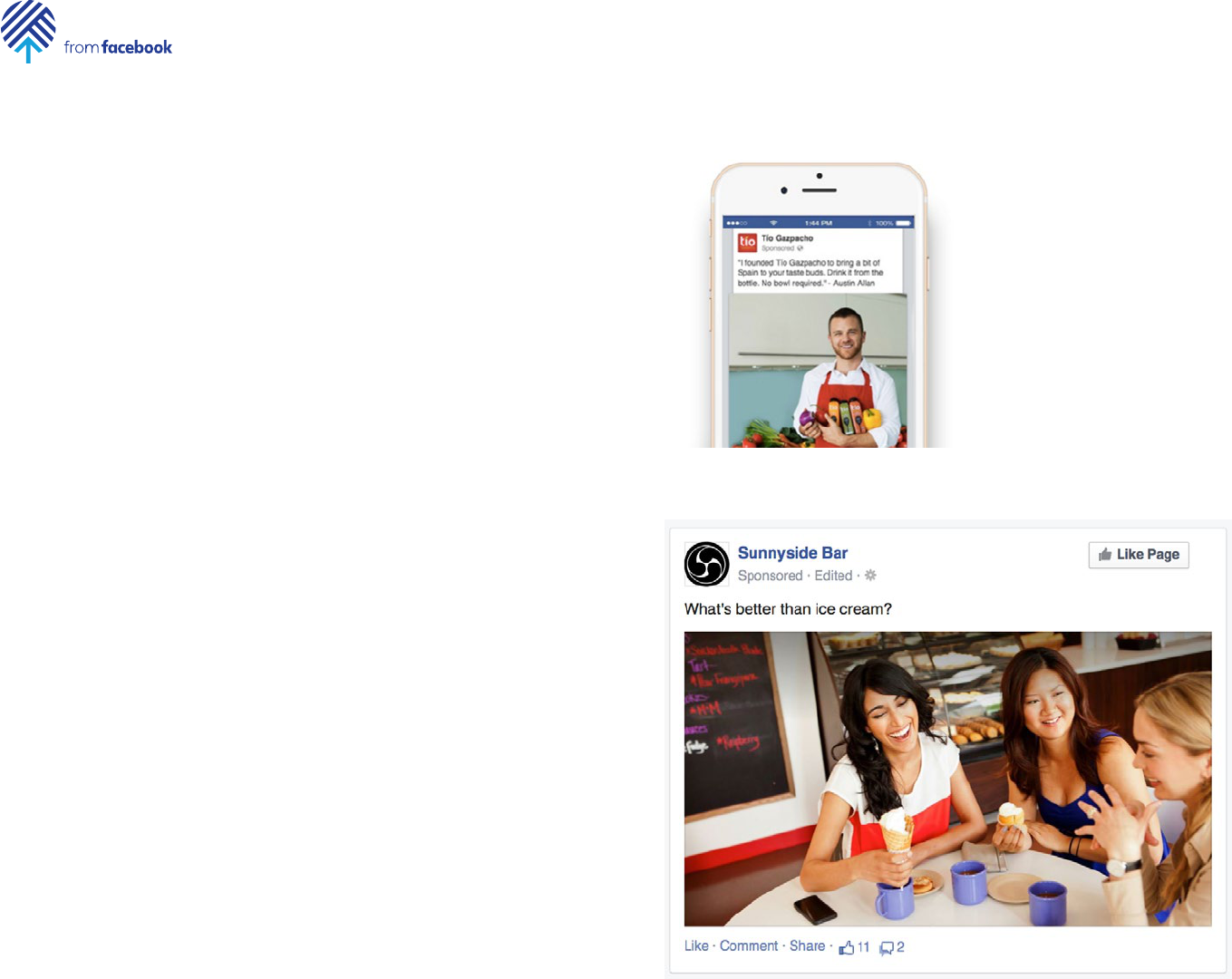
Module 3 Lesson 6: Create Your Ad 55
Social Media
Marketing
What should I think about
as I design and create my ads?
Start With a Goal
Start by choosing a goal for your
ads, then tailor their style and format
around what you hope to achieve.
For example, you can increase
awareness of your brand by using
media that tells a story about the
people behind your products. Here,
Tio Gazpacho’s ad tells a story about
why he started the business.
Show People Using Your Product
Facebook ads often run in
someone’s News Feed or Instagram
feed, right next to posts from
their family and friends. To create
attention-grabbing ads that feel
like a familiar part of someone’s
social fabric, show images of people
benefiting from your product, instead
of just the product itself.

Module 3 Lesson 6: Create Your Ad 56
Social Media
Marketing
What should I think about as
I design and create my ads?
Less (Text) is More
Too much text is distracting and can
lead to your ad being shown to fewer
people. Images that are uncluttered
by text have greater impact.
Focus Your Message
Crop tightly around the important
part of the image. If you’re trying to
fit too much information into a single
piece of media, consider using the
Carousel format to show off multiple
images within a single ad.
If you’re running multiple ad sets
within a single campaign, be sure
all your images have a consistent
theme.
Use High Resolution Images
You don’t have to be a professional
photographer to create great looking
ads. Just be sure to pay attention
to the size and quality of the media
files you’re working with. Find size
recommendations for your particular
advertising objective in the Facebook
Ads Guide.
Play Around
Be sure to play around with different
images and formats before you
commit to a particular ad, and always
preview how your ad will look “in the
wild” before you run it. You can do all
of this over at Creative Hub. You can
also create mock-ups, get feedback
on your creative, and find inspiration
from other advertisers.
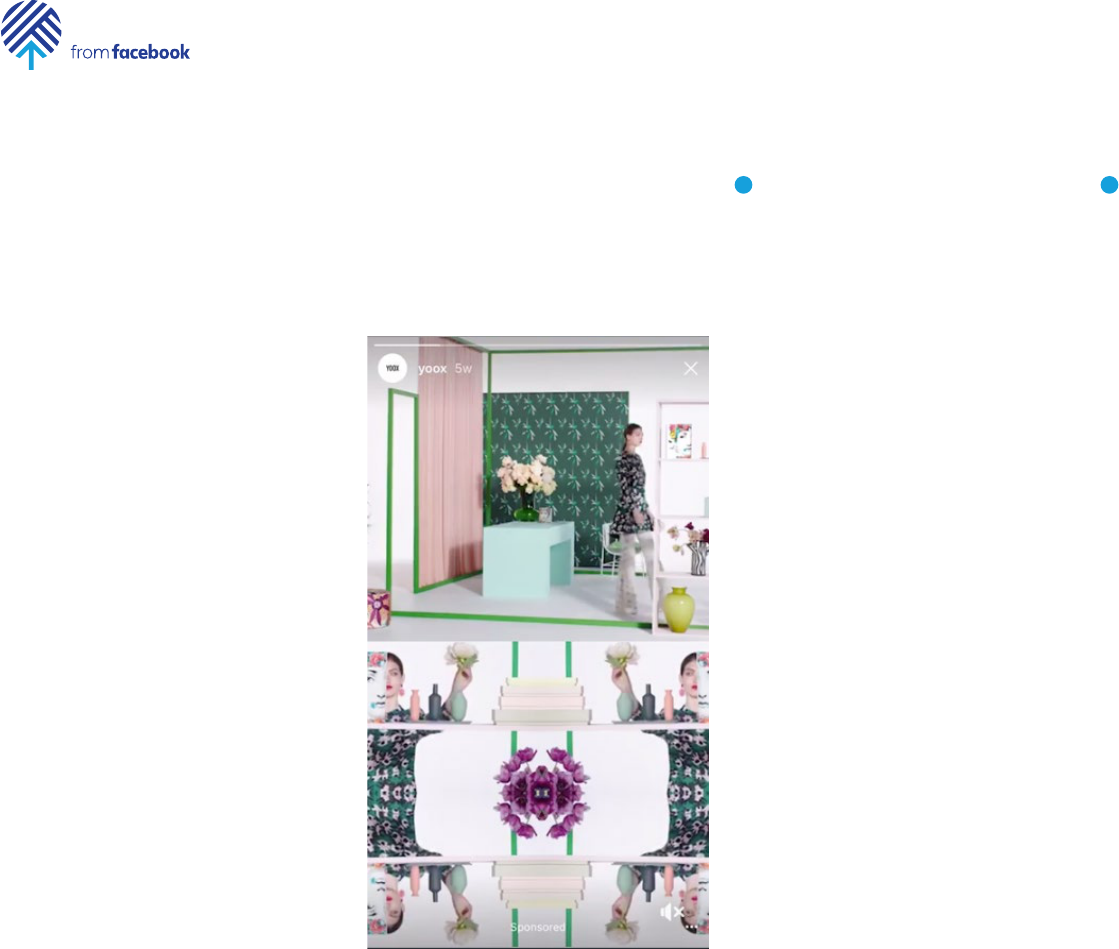
Module 3 Lesson 6: Create Your Ad 57
Social Media
Marketing
What strategies can I use
to create good ads?
What makes a good ad? Good ads
are ads that people interact with.
Think about these 4 elements when
you are creating your ads:
Make it Visual
The more visually appealing you
make your ad the better. It will
be more likely to grab people’s
attention, be shared, and be
remembered. The Facebook
algorithms also treat visual
content more favorably and will
do better when the system is
choosing which ads “win” the
auction to be shown to users.
No matter what type of ad you
create, your image needs to be
visually appealing.
Make it Relevant
Find ways to make sure your
content and ads match the
interests of your audience.
Remember, you are spending
money when someone views or
clicks on your ad (depending on
the settings you use). If you’re
showing ads that aren’t relevant
to your target audience, you’re
wasting your time and money
and will likely not see success
with any kind of advertising.
1 2
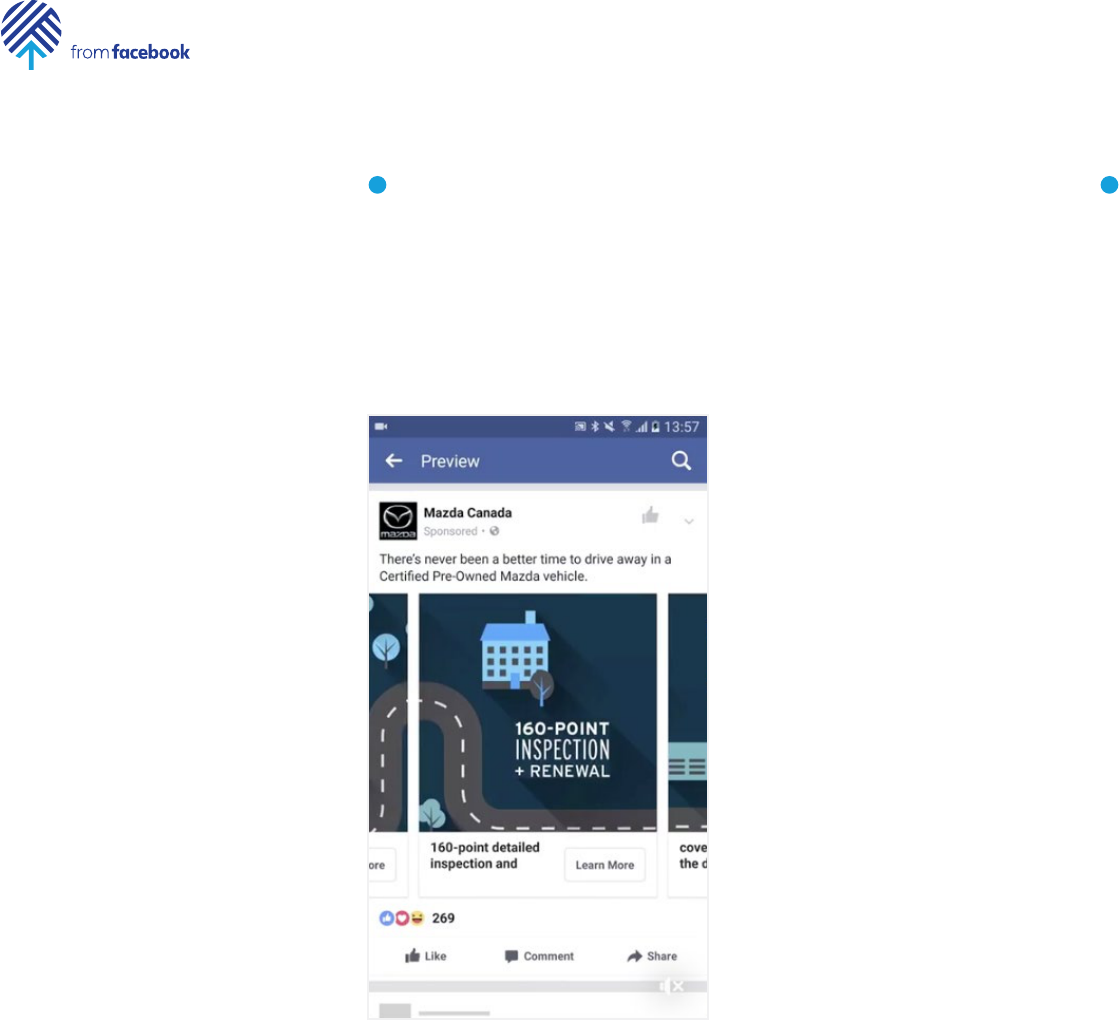
Module 3 Lesson 6: Create Your Ad 58
Social Media
Marketing
What strategies can I use
to create good ads?
Give Them a Value Proposition
A value proposition is the reason
a user clicks on your ad to learn
more about your product. How is
your product or service different
from any other? Why should the
viewer click on your ad?
Your value proposition should be
believable. For example, saying
you have the best massages
in the city will not make people
come to your business’s Page,
but maybe offering 20% off will—
something like, “Nashville loves
a good massage! Come try ours
today and get 20% off your order
with this coupon.”
Give It a Clear Call to Action
A beautiful and relevant ad is
great, but without a call to action
(CTA), your viewer might not
know what to do next. Add a
CTA like “Buy now and save X%,”
or “Offer ends soon” and add a
sense of urgency to your viewer.
Your CTA should encourage
people to click on your ad now.
3 4
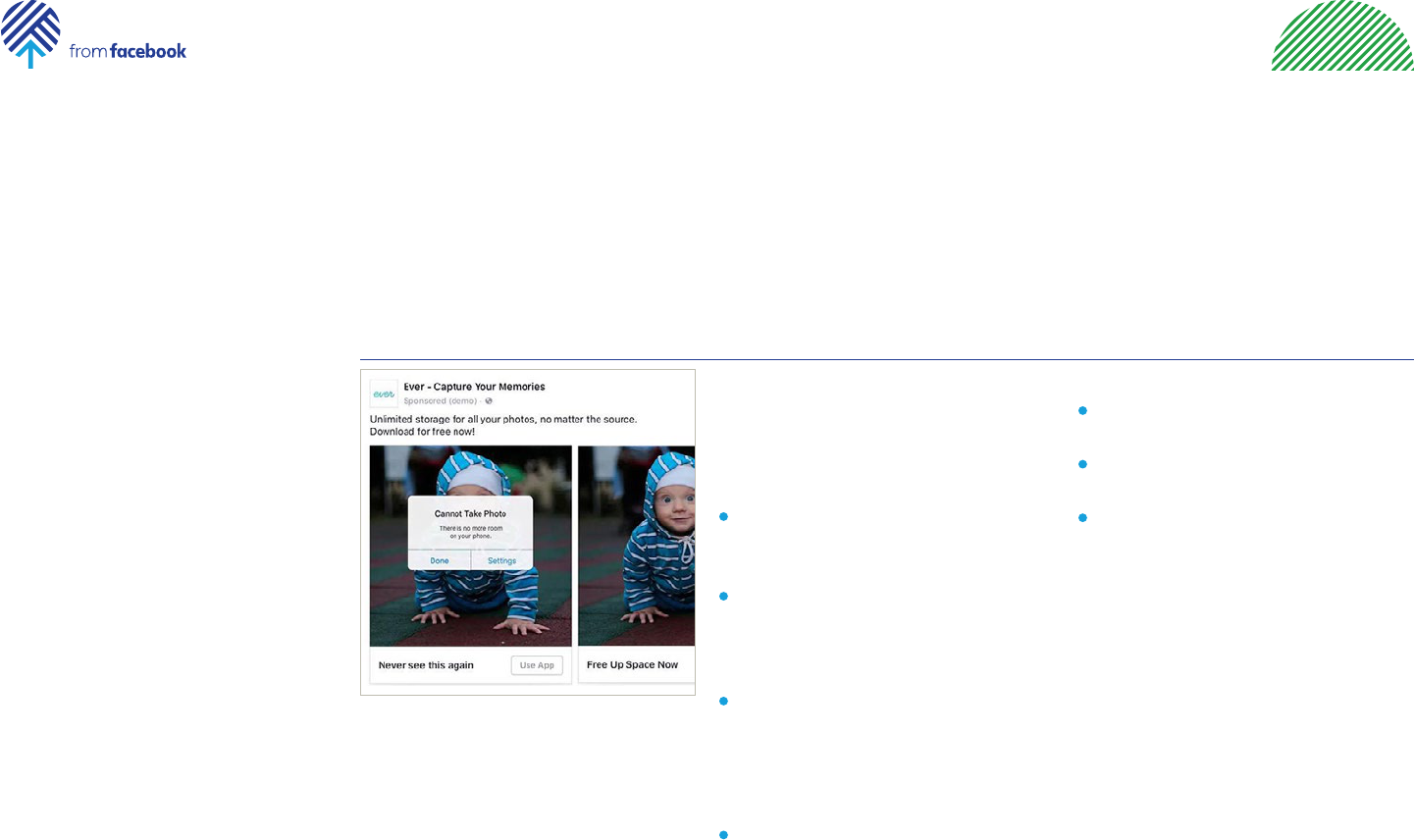
Module 3 Lesson 6: Create Your Ad 59
Social Media
Marketing
Activity:
Creating Good, Effective Ads
To get your creative juices flowing,
look at a few examples of some
different ads. Look for ways in which
Additional Questions:
What elements of this ad strike you
as effective?
What might you change to make it
better?
Are there strategies here that you
can apply to your ads?
each uses strategies for creating
good, creative ads.
Discussion Question:
What strategies do you think make
this a good, effective, creative ad?
Answer:
It’s Visual: This ad uses a carousel
of cute photos showing a familiar
experience for so many of us!
It’s Relevant: It was targeted to
iPhone users, many of whom have
had storage and space problems
with their phones.
It’s Valuable: This ad is full of value.
Words like “Never see this again”
and “Free up space now” help
viewers understand how the app
can help them.
It Has a Clear Call to Action:
Viewers are invited to download
the app for free, and on each photo
in the carousel, you’re invited to
Use the App.
Example 1: Ad and case study from Ever
Resources
https://www.facebook.
com/business/success/
ever

Module 3 Lesson 6: Create Your Ad 60
Social Media
Marketing
Activity:
Creating Good, Effective Ads
Additional Questions:
What elements of this ad strike you
as effective?
What might you change to make it
better?
Are there strategies here that you
can apply to your ads?
Discussion Question:
What strategies do you think make
this a good, effective, creative ad?
Answer:
It’s Visual: This ad uses beautiful,
close up images of their cupcakes
to make them look delicious!
It’s Relevant: It was targeted at
people who lived within 5 miles
of the store, making sure that it
would be easy for them to come
in. After running ads for a bit, they
learned that running ads in the late
afternoon encouraged people to
stop in on their way home from
work for a great dessert!
It’s Valuable: This ad is full of value.
“Berkeley’s Best Cupcakes” and
the images clearly show what the
store offers. Great cupcakes!
It Has a Clear Call to Action:
Viewers are invited to “come
try” the cupcakes and because
they want to encourage visits to
their store, they include a “get
directions” button as well.
Example 2: Ad and case study from Cupcakin’ Bake Shop
Resources
https://www.facebook.
com/business/success/
cupcakin-bake-shop

Module 3 Lesson 6: Create Your Ad 61
Social Media
Marketing
Activity:
Creating Good, Effective Ads
Additional Questions:
What elements of this ad strike you
as effective?
What might you change to make it
better?
Are there strategies here that you
can apply to your ads?
Discussion Question:
What strategies do you think make
this a good, effective, creative ad?
Answer:
It’s Visual: Fun video ad that
uses Cheetos iconic mascot,
Chester Cheetah, and a team
of freestyle soccer stars called
Los Cheetahs. They travel to
many everyday locations such
as a laundromat and a bakery,
entertaining customers with a fun
and unexpected show.
It’s Relevant: The ad was targeted
at parents and younger soccer
fans who also like snacks.
It’s Valuable: The value in this ad is
in the “fun attitude” it promotes—
all associated with Cheetos!
It Has a Clear Call to Action:
Viewers are invited to join the
Cheetos Football Club.
Example 3: Ad and case study from Cheetos
Resources
https://www.facebook.
com/business/success/
cheetos

Module 3 Lesson 6: Create Your Ad 62
Social Media
Marketing
Activity:
Creating Good, Effective Ads
Additional Questions:
What elements of this ad strike you
as effective?
What might you change to make it
better?
Are there strategies here that you
can apply to your ads?
Discussion Question:
What strategies do you think make
this a good, effective, creative ad?
Answer:
It’s Visual: Great photo ads
featuring mouth-watering images
of Nilla Wafers used in a variety
of recipes, including strawberry
shortcake and banana pudding.
It’s Relevant: The ad was targeted
at moms 35-50 years old who
liked snacks and were bakers. The
objective of the campaign was to
remind their target audience that
Nilla Wafers are an easy, fun way to
make delicious snacks.
It’s Valuable: The ads provide great
ideas for simple, fun recipes to
make and share.
It Has a Clear Call to Action.
Because this was a brand
awareness campaign, viewers
were invited to “like” the Nilla Wafer
Page to get more recipes and fun.
Example 4: Ad and case study from Nilla Wafers
Resources
https://www.facebook.
com/business/success/
nilla-wafers

Module 3 Lesson 6: Create Your Ad 63
Social Media
Marketing
This mini-challenge has two parts.
Part 1
Prepare the creative for your ads.
You’ll want to prepare 2-3 ads to
run in this first campaign. Try to
experiment with different ad formats
as much as you can.
Gather the photos and/or videos
(or go take a few if you need to!)
you want to use.
Write the copy you’ll use. Keep it as
short and engaging as you can—
just like you would in a post.
Decide on your call to action. You’ll
want to make sure you are asking
your audience to DO something
in response to your ad—Like your
Page, go to your website, sign up
for an event, buy something.
Mini Challenge:
Create Your Ad
Part 2
Use Ads Manager to create your first
ad campaign.
You will use all that you’ve prepared
in this module to create your first
real, running ad. Make sure you have
the following things ready before you
start:
Your ad objective
Information you will use to target
your audience (demographics, age,
location, interests, behaviors)
The amount of money you want to
spend on the campaign
The creative—photos, videos,
copy—for your ad
Ready? Let’s get started!

Module 3 Lesson 6: Create Your Ad 64
Social Media
Marketing
Before you get started running your
ad, it’s important to set some goals.
Remember, setting goals will help
you measure how well you are doing.
Think about actions you want people
to take with your ad. Do you want
them to link to your website, Like
your Page, buy something, sign up for
an event? Think about the numbers
of people you think you’d like to take
that action. What about the people
you want to reach?
It’s okay to keep your goals modest
until you learn more about what
works and what doesn’t with your
audience.
Mini Challenge:
Set Goals for Your Ad
My Goals:
action I want people to take
number of those actions:
target audiece:
amount of money to spend:
gender
location
age
Now have a discussion and write a
brief paragraph describing what it is
you think makes people engage with
some ads but not others. Yes, the
simple answer is that some ads are
more interesting to certain people,
but a lot of ads get ignored because
there are so many. What kind of
emotion or attitude is going on in
a person’s head when they choose
click on an ad in Facebook?

Module 3: Lesson 7
Manage and
Measure Your Ads
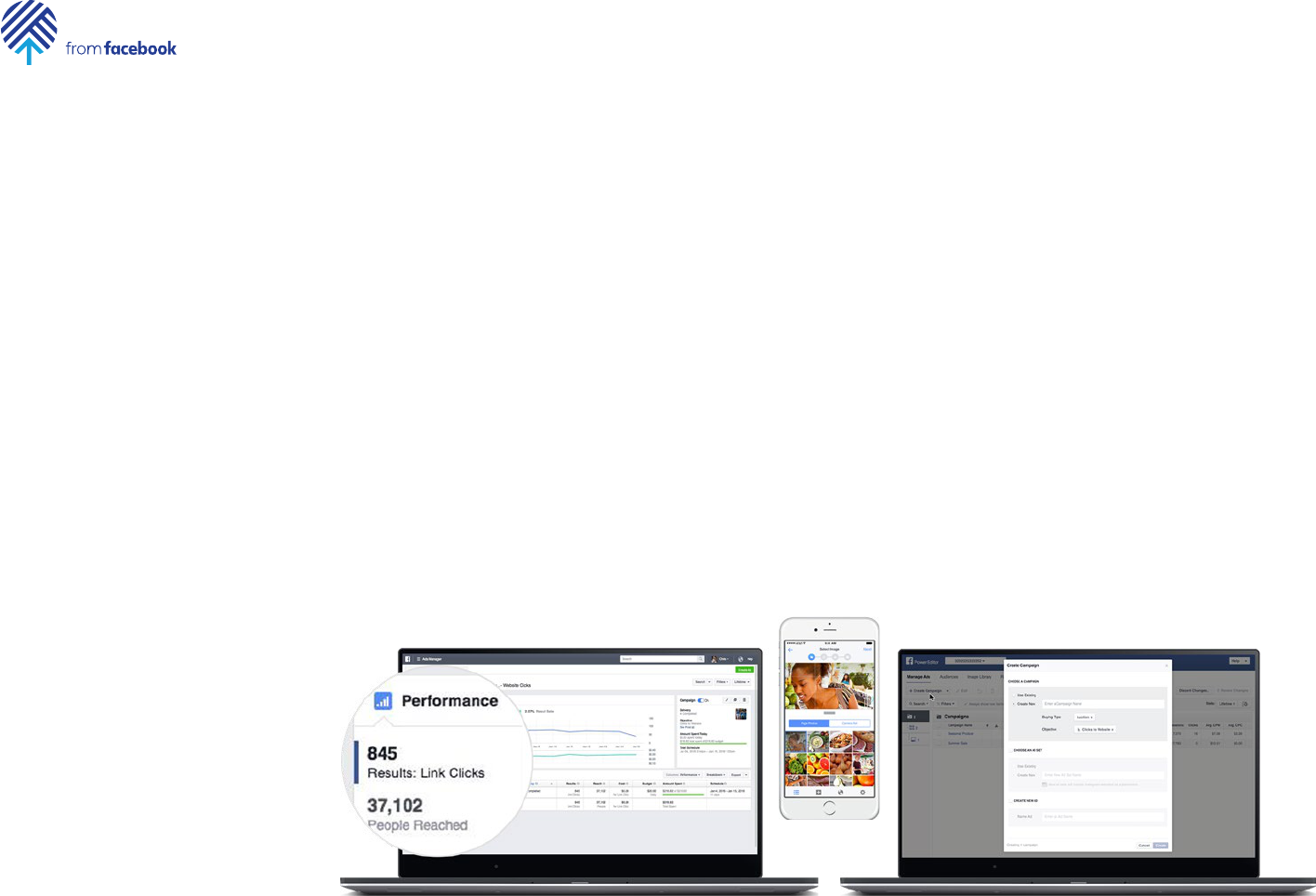
Module 3 Lesson 7: Manage and Track Your Ad 66
Social Media
Marketing
What tools do I use to
manage and measure my ads?
Creating great ads on Facebook is
just the beginning. You’ll also want
to measure the effectiveness, reach,
and quality of your ads. Facebook ad
management tools give you several
ways to do this, based on how many
and what kinds of ads you’re running.
See what’s working and what’s not,
and experiment with different images
and headlines to gauge what gets the
best reaction. You can also create
and manage your ads right from your
phone, wherever you happen to be.
You’ll use the same tools you use
to create your ad, to manage your
ad—Facebook Ads Manager or the
Facebook Ads Manager App.

Module 3 Lesson 7: Manage and Track Your Ad 67
Social Media
Marketing
Ads Manager
Use Ads Manager’s powerful features
to analyze results and make informed
changes to your ads and campaigns.
In Ads Manager you can:
Quickly duplicate your ads, ad sets,
and campaigns.
Edit all your ad settings, such as
targeting and budget, from one
place.
See all the metrics that matter to
you, right from one consolidated
view.
Customize your graphs and tables
to see the metrics most important
to you.
What tools do I use to
manage and measure my ads?

Module 3 Lesson 7: Manage and Track Your Ad 68
Social Media
Marketing
What tools do I use to
manage and measure my ads?
Ads Manager App
With the Facebook Ads Manager app
for iOS and Android, you can monitor
current ads or create new ones from
anywhere.
Download the app for free on the
App Store or Google Play Store, and:
Create ads
Edit existing ads
Measure ad performance
Receive push notifications

Module 3 Lesson 7: Manage and Track Your Ad 69
Social Media
Marketing
How do I use Ads Manager to measure ad
performance?
Ads Manager shows you how
your advertising is helping you
achieve your business goals across
Facebook, Instagram, and Audience
Network. You can analyze your
campaign results and learn more
about your audience, your product
sales, your campaign’s reach, and
much more. With this data, you can
make more informed decisions
when building your campaigns and
ultimately improve your results.
Under the Account Overview tab,
you can view a detailed summary of
all your advertising activity, learn how
your campaigns are performing, and
gain insights for future campaigns.
First, you can use the charts to
understand how your campaigns are
performing over time and analyze
trends. Hover over the charts to see
more information on your campaigns.
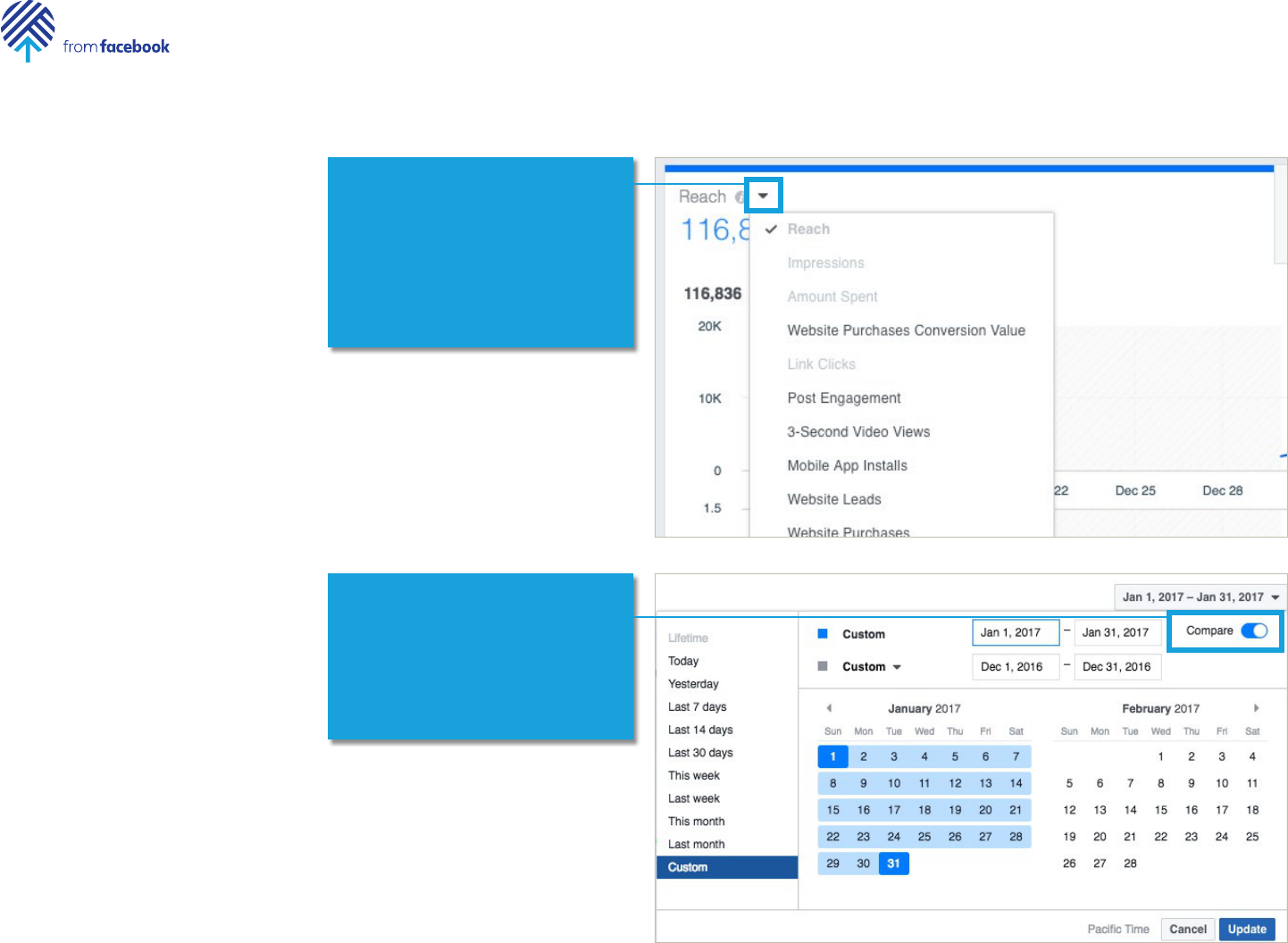
Module 3 Lesson 7: Manage and Track Your Ad 70
Social Media
Marketing
How do I use Ads Manager to measure ad
performance?
You can customize the metrics you
want to see. There are four sections
with metrics you can adjust (such as
reach, impressions, amount spent, and
link clicks). To change the metric you
see in a section, click the icon next to
the metric name and choose a new
metric from the list.
You can compare your results between
two time periods to understand if your
ads performed better in one period
over another. Click on the date range
drop-down menu. Click Compare and
choose the dates that you want to
compare.

Module 3 Lesson 7: Manage and Track Your Ad 71
Social Media
Marketing
How do I use Ads Manager to measure ad
performance?
If you want to see what group of
people are interacting with your ads
based on age and gender, select
Age & Gender, Age, or Gender.
To see the location of the people
viewing your ads, select Country,
Region, or DMA.

Module 3 Lesson 7: Manage and Track Your Ad 72
Social Media
Marketing
How do I use Ads Manager to measure ad
performance?
You can also see what time of day
people are viewing your ads and the
corresponding ad spend.

Module 3 Lesson 7: Manage and Track Your Ad 73
Social Media
Marketing
What data do I look at to
understand my ad performance?
Most of the time what data you
should look at depends on your goal,
but there is a way to think about
this overall.
In most cases, it is useful to think
about these four things:
Actions
Cost Per Action
Spend
Frequency
Actions
For campaigns you run, you know
what action you want your audience
to take, like make a purchase on your
website (conversion).
Make sure you are clear about
what action you want and use the
Facebook reports to monitor that
action.
There is a long list of actions that you
can monitor. In fact, the Facebook ad
reports provides dozens of options to
choose from. Choose the ones that
are appropriate for your ad.
Cost Per Action
The number of actions alone may
not provide enough information
about your ad performance. If one
ad generates 20 actions, is it more
successful than an ad that generates
15? Not if its costs you more money
to get those 20 actions.
For most actions, you can monitor
your costs in Ads Manager.

Module 3 Lesson 7: Manage and Track Your Ad 74
Social Media
Marketing
What data do I look at to
understand my ad performance?
Spend
It’s often a good idea to combine
the Cost Per Action metric with the
spend. The spend will tell you if you
need to shift your budget from one
ad or campaign to another. Or raise
or lower the spend of an effective or
underperforming ad.
Frequency
Frequency is the average number of
times your audience sees your ad. It’s
related to reach and the number of
impressions your ad has had.
You might think that the more times
they see your ad the better, but in
fact, there is a balance you have to
think about. You don’t want people to
see your ad so many times that they
ignore it completely, or worse, get
angry about seeing it so much.
In general, think about a frequency
score of 5.0–too much higher than
that might mean that you viewers are
getting ad fatigue.
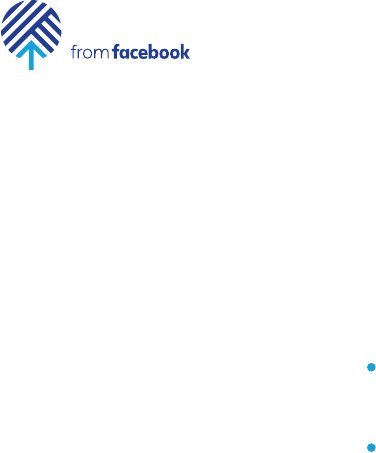
Module 3 Lesson 7: Manage and Track Your Ad 75
Social Media
Marketing
What is the difference between
Cost per Click and Cost per 1,000
Impressions?
On Facebook (and in the digital
marketing world in general), there are
two ways to think about costs:
Cost per Click (CPC) is the cost
for 1 click on your ad.
Cost per 1,000 Impressions (CPM)
is the cost for 1000 impressions/
views of your ad.
If your goal is to get people to take
a certain action–such as getting
people to click on your website–
you should select CPC. This is
because Facebook will show your
ad to people who are more likely to
complete that action. If you want a
lot of people to view your ad, choose
CPM but keep in mind that your
ad may get shown to more people
overall, but not necessarily those
who will follow your link or “Like”
your Page.

Module 3 Lesson 7: Manage and Track Your Ad 76
Social Media
Marketing
How do I monitor the amount that
I am actually paying for my ad?
When you want to see how much
you’re spending on your ads, you can
see an estimated daily spending limit
in Ads Manager. In the Billing section
of Ads Manager, you’ll find all your
final charges including the specific
ads you paid for and exactly what
you paid for, like running an ad for
awareness or getting people to click
your ad.

Module 3 Lesson 7: Manage and Track Your Ad 77
Social Media
Marketing
How do I set a spending
limit on my account?
You can set an account spending
limit to ensure your ad account
doesn’t spend more than you’re
comfortable with. If you set an
account spending limit, your ads will
turn off when your limit is reached.
An account spending limit is an
overall limit on how much your ad
account can spend over its lifetime.
It doesn’t reset automatically after
a certain amount of time, such as at
the end of the month. To continue
advertising after you’ve reached your
limit, you can reset, the amount spent
toward your limit to $0.
You can create, change, reset or
remove a spending limit on your
account at any time.
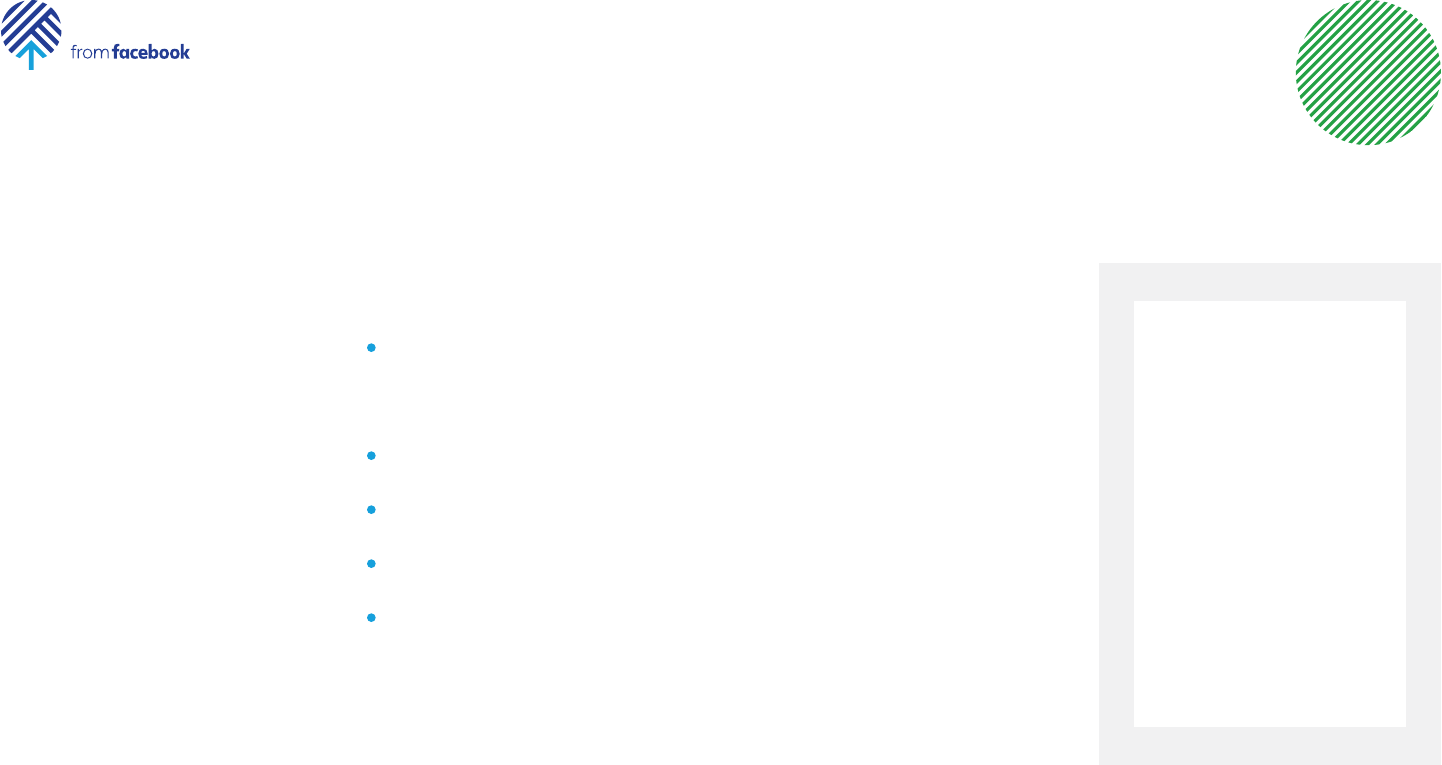
Module 3 Lesson 7: Manage and Track Your Ad 78
Social Media
Marketing
This week, as your ad runs, use Ads
Manager or the Ads Manager App to
monitor ad performance.
Depending on your objective, you’ll
want to look at several things:
Did your ad generate the number
of link clicks to your website or
signups for your event that you
were hoping for?
What was the cost per click,
signup, etc.?
What have you spent so far on the
ad campaign?
What is the frequency that your ad
is being shown?
What else can you learn about
how your ad is doing with your
audience?
Mini Challenge:
Measure Your Ad Performance
Reflect and analyze your results,
perhaps with a partner or in a class
discussion. What surprised you?
What went well? What isn’t going so
well? What can you tweak or change
that you think will help?
Don’t worry if things didn’t go as well
as you hoped. This is your first try.
Even the most experienced digital
marketers have to try, fail, and try
again to learn what works and what
doesn’t. Don’t be afraid to explore
and try new things!
Write down this reflection. You’ll need
it for the Micro-credential.

Module 3 Lesson 7: Manage and Track Your Ad 79
Social Media
Marketing
Now’s your chance to take what
you’ve learned from creating
and running your first ad and do
something different with a second
ad. Use the creative—images, videos,
etc.—that you created for other ads in
Lesson 6 to start another ad.
You’ll want to have the same things
ready before you create your ad:
Your campaign objective
Information you will use to target
your audience (demographics, age,
location, interests, behaviors)
The amount of money you want to
spend on the campaign
The creative—photos, videos,
copy—for your ad
Mini Challenge:
Run and Measure a Second Ad
And then you’ll want to monitor your
ad regularly to see how it’s doing.
Be creative. Try something different.
Who knows what you’ll learn when
you explore and try new things!
At the end, do another reflection
(with a partner or in class) about how
this second ad performed and write
it down. You’ll also use that reflection
for the Micro-credential.

80
Social Media
Marketing
Get the Micro-credential
Congratulations! You have completed this module by:
Choosing your ad objective for your ad
Choosing your target audience for your ad
Setting a budget and schedule for your ad
Creating 2-3 ads of different types (image, video, carousel etc.)
Measuring and monitoring ad performance to learn what is working and
what is not
Once you think you’re ready, you can
submit your work for review to earn
the Marketing with Facebook Ads
Micro-credential. Your instructor will
have instructions as to how to do
the submission.
With this micro-credential, you can
show employers and others that you
have demonstrated the basic skills
needed to run a basic ad campaign
using Facebook!
We invite you to continue developing
your skills with the next module,
Marketing with Instagram.
